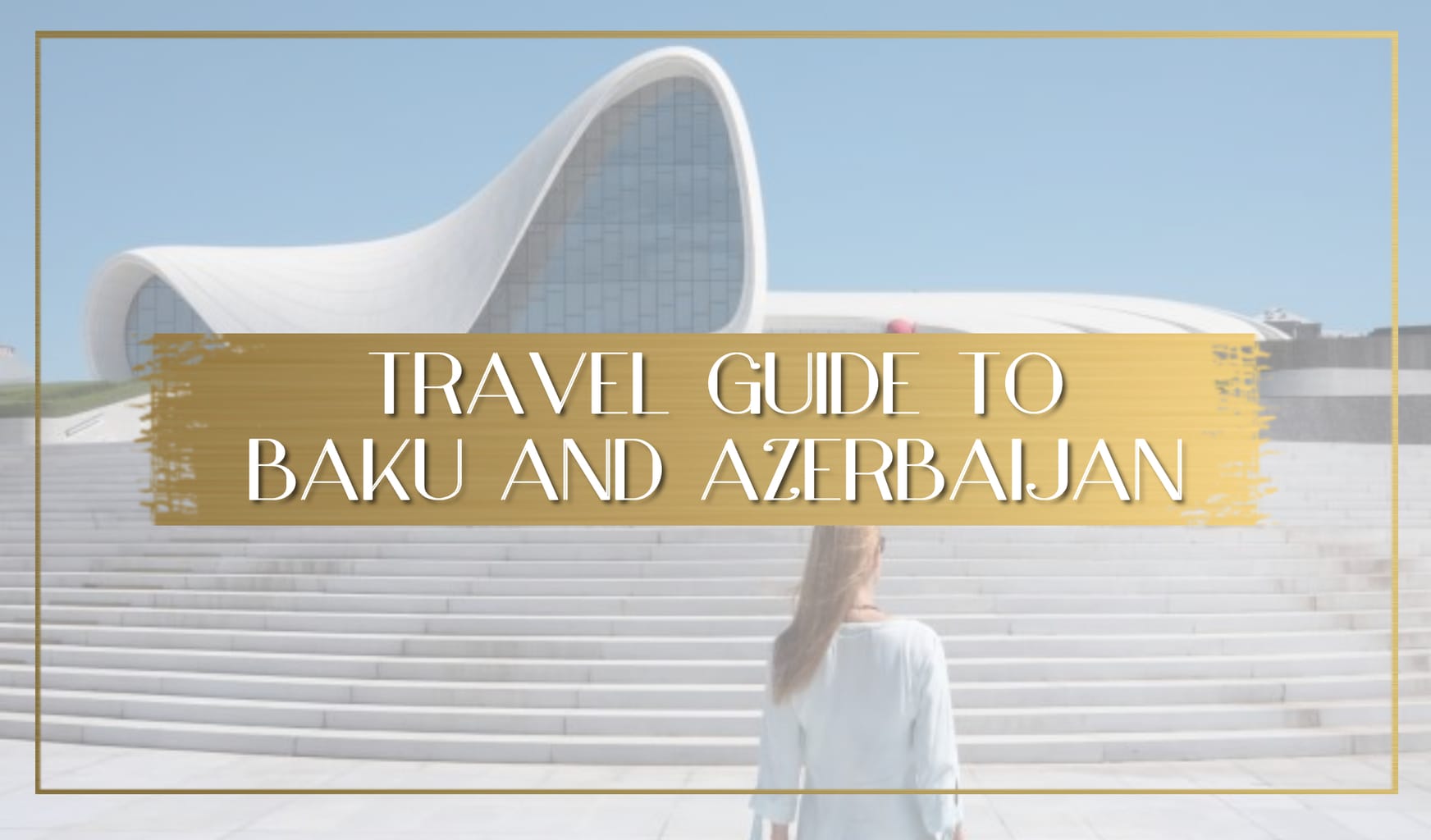
You may have never heard of this country before but I assure you that there are a lot of things to see and do in Azerbaijan and after reading this guide to the best places and activities in Baku and surroundings you may want to book a flight straightaway and get that rare passport stamp.
Luckily, this travel guide provides you with everything you need to know before going to Azerbaijan, from the best places to visit to the best restaurants, foods to try, sights and activities and even the best places to stay at. It is the ultimate guide to Azerbaijan and it will give you many reasons to put it on your bucket list. But book soon, because the country is set to become the next European destination now that online visas are easily obtained in three days.
Did you know that the word Caucasian comes from the first inhabitants of northern Azerbaijan? Or that the word Azerbaijan evolved from the words for Land of Fire in ancient Greek? Have you ever heard of the country’s mud volcanoes? And did you know that there is a spot in Azerbaijan that has been burning for over 4,000 years non stop? Read on to discover more about this fascinating Caucasus country.
Watch the video of my journey through Azerbaijan below:
Baku and Azerbaijan Travel Guide – Where is Azerbaijan?
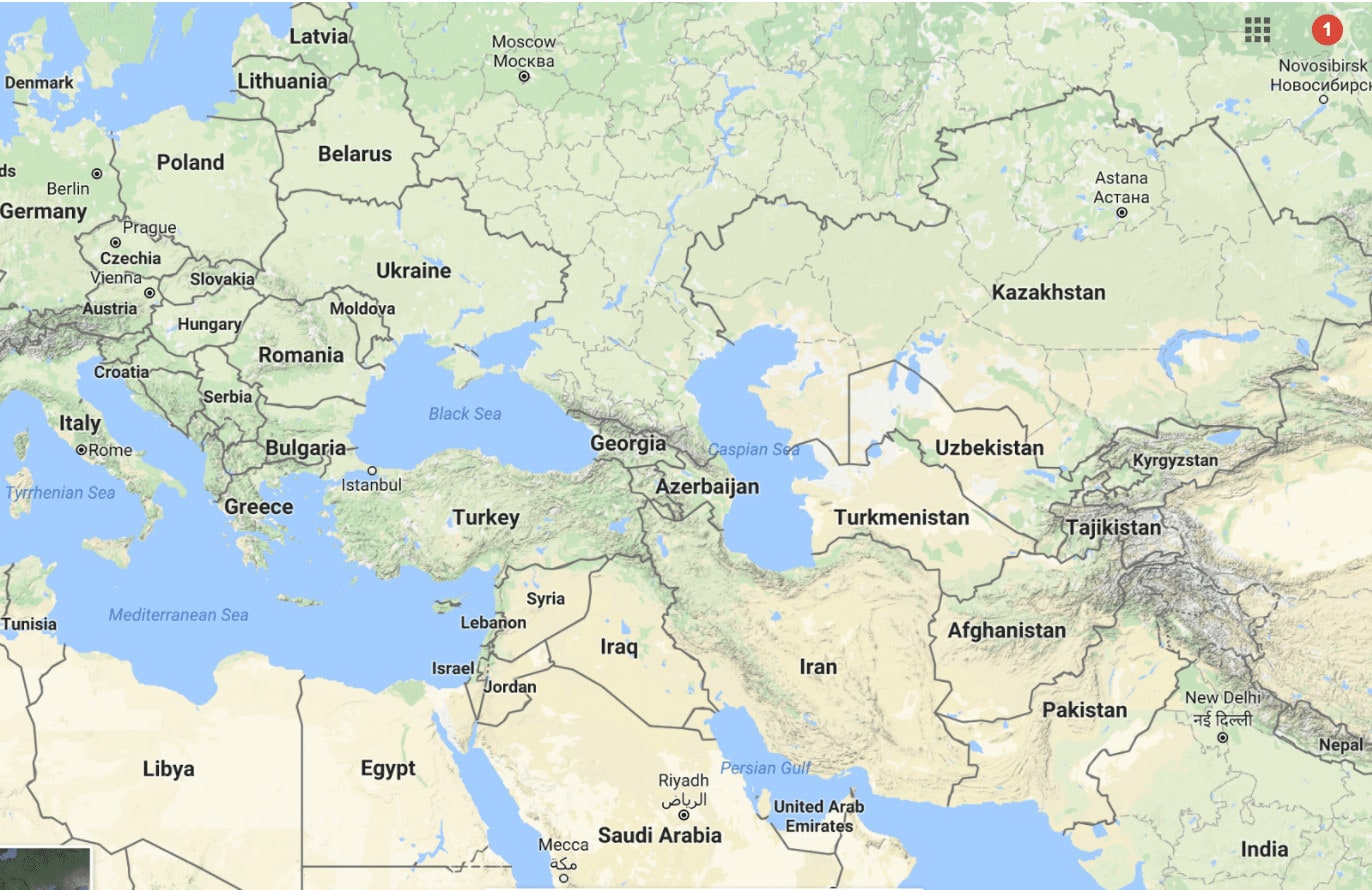
Is Azerbaijan in Europe or in Asia? This may seem like a straightforward question but it is not. Azerbaijan is one of those trans-continental countries like Turkey or Russia which straddle two continents. That is, a part of the country is technically in Europe and another, the majority of it in fact, lies in Asia.
When you visit the country you will notice that locals call themselves European. Their currency look exactly like the Euro in fact and they define themselves in relation to Europe and not to Asia. However, the country is technically across the border between the two continents which is conventionally defined along the Caucasus mountain range.
The countries south of the range are in Asia and those in the north are in Europe. In the case of Azerbaijan that would mean that only a small portion of the country is actually in Europe as the Caucasus is located on the northern part of the country.
So where is Azerbaijan? If we take the CIA World Factbook classification, it is a Middle Eastern country in Asia. But I prefer to include it in Europe because that is how the locals felt.
See more fun and interesting facts about Azerbaijan in this article.
Azerbaijan’s history
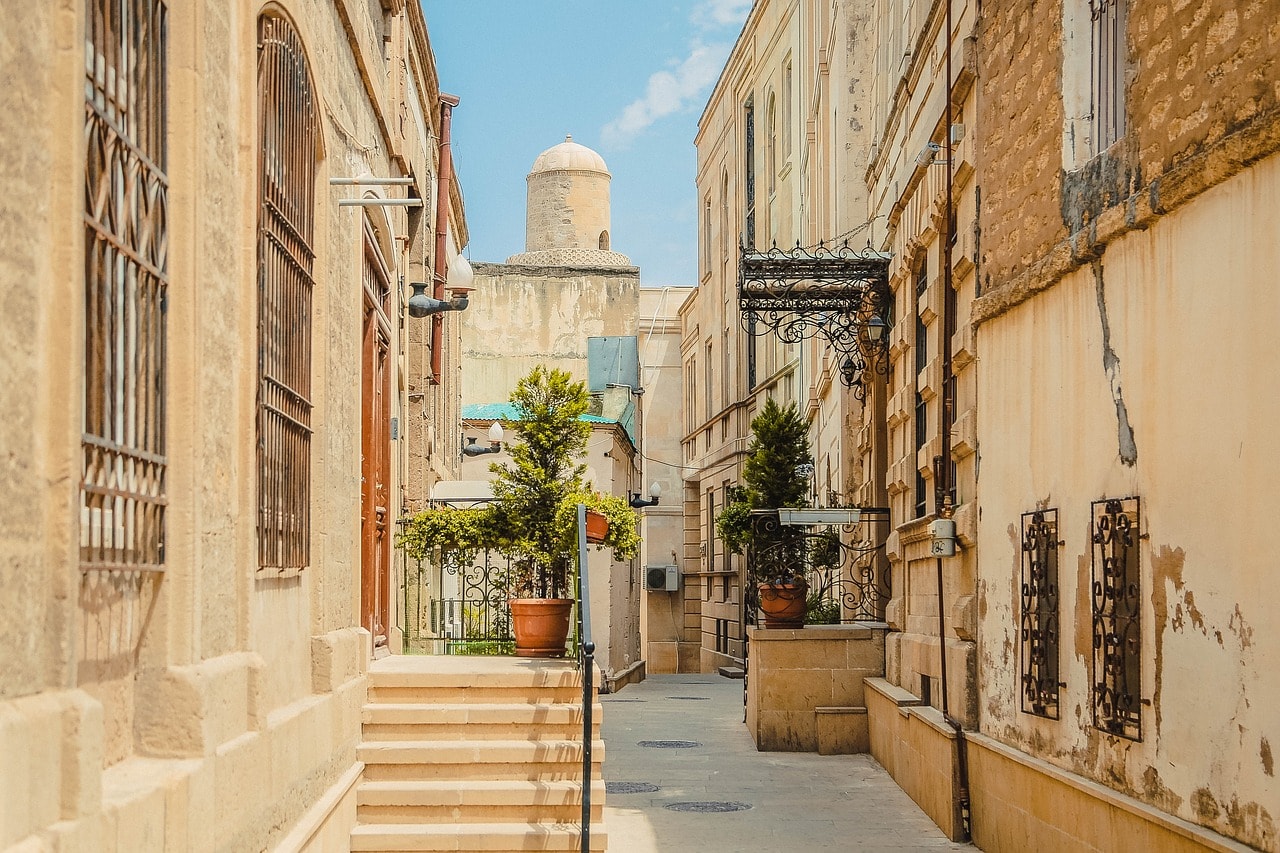
Azerbaijan’s history is rich. Its past dates back to thousands of years ago, including remains of a city underground that is over 2,000 years old and rock paintings dating back to the Stone Age. Proto-human evidence dating back 700,000 years ago was found in the Azokh caves and later human settlements can be traced to the Paleolithic and Bronze Age. The Gobustan Rock Paintings are a UNESCO listed site proving existence of human life in the 10th millennium BC, during the Mesolithic times.
The country has been a part of many empires, from Alexander The Great’s to the Ottoman, Persian or Russian Empire. It is because of this melting pot of East And West that it is such a fascinating destination with a rich and constantly changing psyche. Many consider it the East in the West and the West in the East, and I could not agree more with that statement.
The earliest inhabitants of Azerbaijan are believed to have been the Caucasian Albanians. These are the peoples who have given name to the word we use to refer to “white” people today, Caucasian because of their very fair features. They were succeeded by several tribes and empires through the centuries.
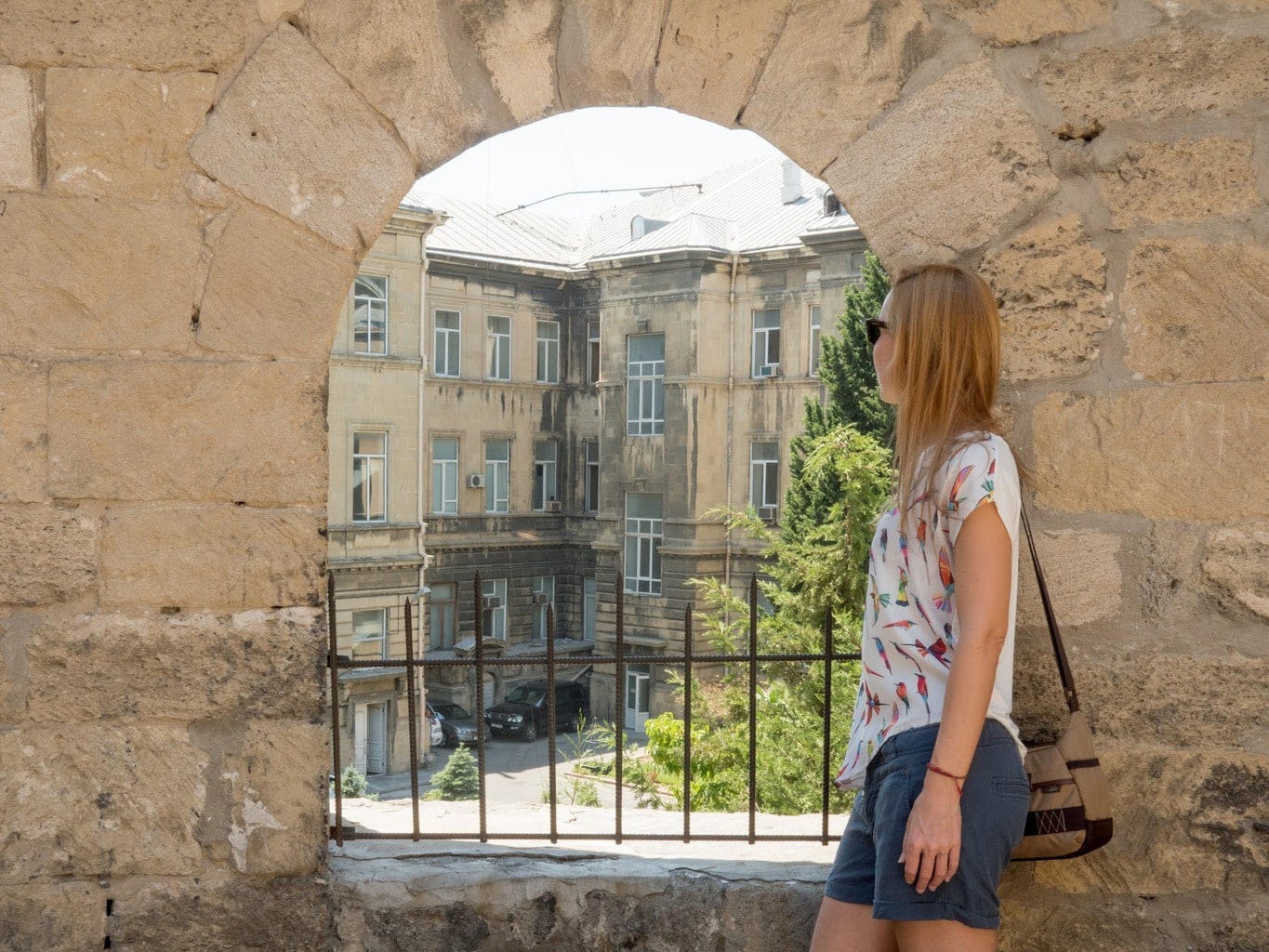
Here is a brief Azerbaijani historical timeline:
- Azerbaijan was invaded by the Achaemenids (also known as the Persian Empire), led by the Persian King Cyrus The Great around 550 BC. This invasion brought Zoroastrianism with it. Although the religion has not survived till today in the country, remnants of it can be found across the country and in the fire worshipping temples that were typical of the faith. This is also the reason Azerbaijan is often referred to as the Land of Fire.
- The Achaemenids were defeated by the Greek King Alexander the Great in 330 BC.
- In the 3rd century BC, invasions from various Persian tribes eventually led to the area’s independence which was short lived as the Roman and Parthian empires battled for expansion in the region and conquered parts of it.
- The Parthian Empire ruled Caucasian Albania from the 1st to the 5th century AC at which point the Arab Caliphate arrived and invaded the area bringing Islam with it. Islam is still the largest religion in the country although Azerbaijan is not a religious state and more than half of its population do not consider Islam has an impact in their day to day life.
Azerbaijan’s recent history starts in the 19th century when Tsarist Russia won control over the area after signing treaties with the Persian Empire. Russia ruled over Azerbaijan for 80 years until it collapsed and the country proclaimed independence in 1918.
But this was short-lived as in 1920 the Red Army invaded Azerbaijan and annexed it to the Soviet Union where it remained until the Soviet Union’s demise in 1991. That year, Azerbaijan regained its independence again and became a secular republic with a majority muslim Shia population.
First impressions when visiting Azerbaijan
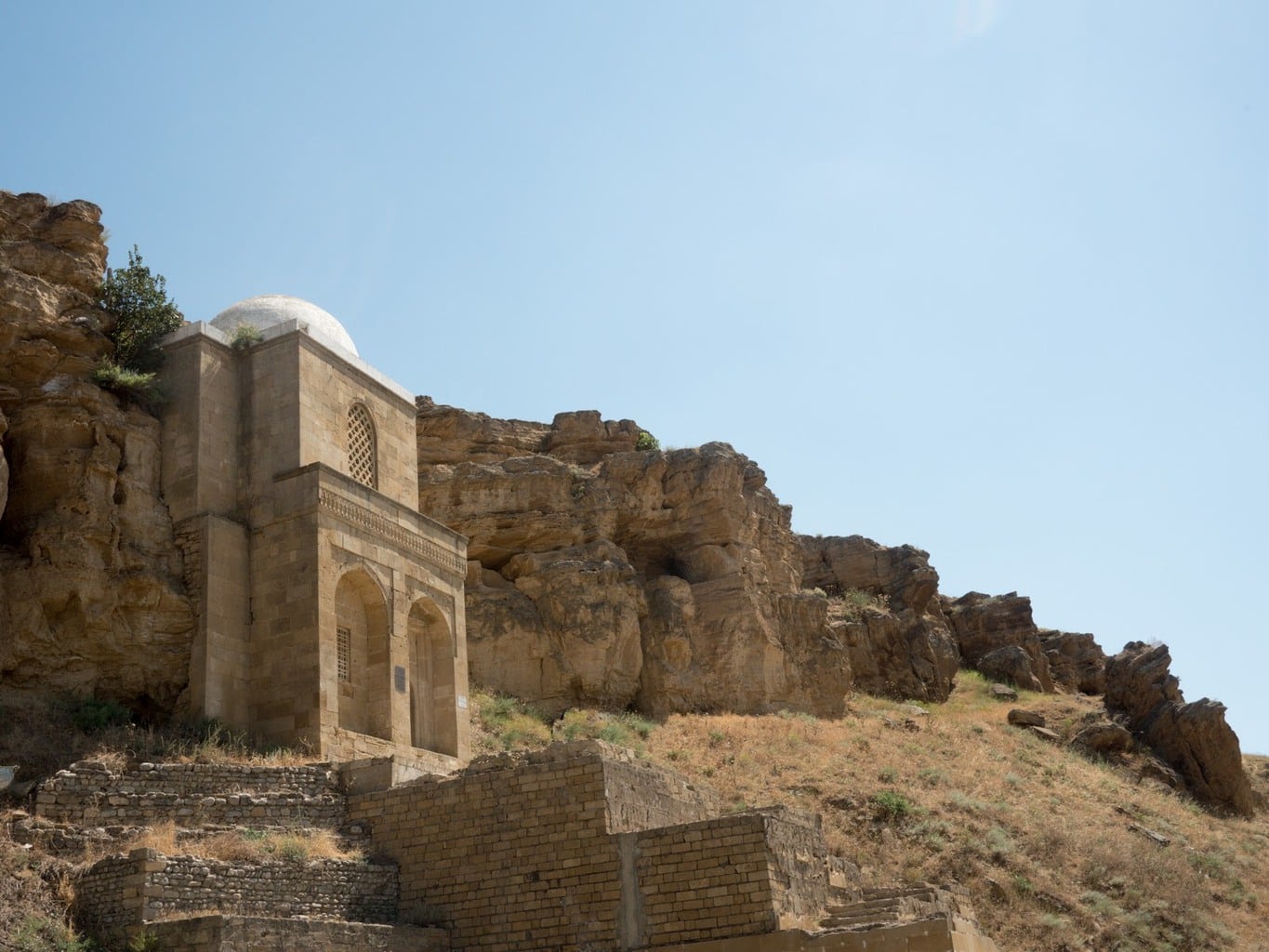
Azerbaijan share a border with varied countries like Iran, Russia, Turkey, Armenia and Georgia. It is also located by the Caspian Sea so it has direct access to water. If your country is one of the 95 that make up the ASAN Visa program, you can get your eVisa online and enter for 30 days. If not you may need to get some help to discuss your country’s travel requirements to Azerbaijan.
Azerbaijan is a place where East meets West, where Asia and Europe are both present but do not dominate, where religion is pervasive but most people don’t define themselves by it. It is a unique country, the result of its dynamic past and its privileged position in the ancient trading routes between the Far East and Europe.
You can find caravanserai from the Silk Road times, Zoroastrian fire temples, beautiful mosques and remains of a church built by one of Jesus’ Apostles. Oil reserves have brought flashy buildings that go up in flames at night, but outside of Baku the rural areas are remarkably peaceful and picturesque.
The landscapes also reflects this paradox. Baku is surrounded by desert landscapes while Qabala and the rest of the country is fertile, green, lush and mountainous even. From the lowest point below sea level, the country rises to over 4,000m at its highest peak in the Caucasus range.
The city is modern but has dashes of well-preserved rich history. People are willing to help and always ready to give advice or point you in the right direction, even if they look serious and do not speak a word of English. We found everyone to be incredibly useful and welcoming.
Things to do in Baku with map
Since the country relaxed its visa requirements and started offering electronic visas in 2016 it has started to attract interest from international visitors but if you venture out to explore Baku or the rest of Azerbaijan you are likely going to have it all to yourself.
Even in the peak summer months the number of tourists is minimal. This is great news because there is a lot to see and do in Baku and surroundings. Although this list is not exhaustive, it contains all the best things to do and see in Azerbaijan which you can cover in a week.
Things to do in Baku
Here is a complete list of the best things to do in Baku, Azerbaijan.
1. Go on a walking tour of Baku’s Old City
The Old City of Baku is a walled city built between the 12th and 16th centuries and is locally referred to as Icheri Sheher. Because of its richness and value it is listed as a UNESCO site.
You can go on a guided walking tour or you can head to the tourism kiosk that is in front of the Maiden Tower and get the audio guide to follow on your own. Just like in a Museum, there are marked points and an itinerary you can just follow to hear more about the key sites in Baku’s old city. During the tour you will visit a lot of the landmarks that are mentioned in the next points. They are chronologically mentioned so you can follow the map and a logical route.
2. The Fortress Wall
The fortress wall that encloses the city dates from the 12th century but has been destroyed and restored several times through the centuries so most of the construction dates more from the 13th to 15th centuries.
In the 16th century, a second fortress wall was constructed, lower than the 12th century one, as a means to defend from invaders who would jump the lower one only to find a higher wall and be trapped in the water-filled moat that was in the middle as an easy target. In the 19th century, the second wall was demolished as the city grew with the oil boom and the area needed to be expanded.
The original wall had only one entrance and one exit right along one straight road crossing the city. The original entry gate can still be seen today and I have marked it on the map. Above the opening look out for the shield of the city. You will see the head of an ox which represents the city of Baku. The ox is protected by two lion heads during the day and night, hence the picture of the sun and the moon.
The wall has 25 towers and five gates.
3. Caravanserais
Caravanserais are the former version of an Inn. Nomads and traders traveling along the Silk Route needed a place to rest and eat through their travels and so caravanserais started to appear along the main trading routes. I have seen them from Morocco to India and they are often very beautiful buildings converted into historical, even luxury, hotels.
The architectural design is always the same no matter the country. A courtyard in the middle was used to host the animals (camels, horses) and the rooms were around it. Some caravanserais have two floors.
There are a few caravanserais in the Old City but there are two marked in the map that are the most beautiful and well-kept caravanserai dating back to the 14th century (although have been restored to modern-day restaurants). They are located right in front of each other in a narrowing along the main street from the fortress entrance gate.
One is called Bukara caravanserai and was used to host people who venerated one God only. That meant, for Christians, Zoroastrians and Muslims which were not the majority at the time. The other one, the Multani caravanserai, was open to people who venerated many Gods, that is Buddhists and Hindus who were the majority at the time.
Although Multani looks half the size of Bukara, the majority of it is actually underground. Caravanserai are pleasant places to enjoy a drink under the shaded trees and arched rooms.
4. Maiden Tower
This interestingly shaped tower is believed to have been built in the 5th or 6th centuries but its exact construction date is unknown. The Maiden Tower is used as a symbol of the city of Baku and together with the Old City and the Shirvan Shahs Palace it is inscribed as a UNESCO site.
Although archeologists and historians are not sure about its origins and the purposes of its existence and shape, there are three theories to explain its existence and evidence to support all three.
A first theory states it was a defense tower that may have been part of the fortress walls of the city. A second theory asserts this was an observatory to the moon and the celestial bodies above. A third theory mentions that the Maiden Tower was a fire worshipping temple because its shape from above is that of a buta, the symbol that represents fire, the sun and light, similarly shaped to a number nine or a tear. It is possible that the tower was used for all three purposes.
As per its cylindrical shape with a buttress like addition, it is possible that it had nothing to do with fire-worshipping but that the buttress part was added to support the tower’s foundations. Or that the tower was the key to the city as its shape can also be that of a keyhole, to the city of Baku.
Aside from the three possible uses for the Maiden Tower, there are several legends to explain its name. The most romantic one relates to the story of a young princess who threw herself from the top of the tower when asked to marry someone she did not love. A less tragic origin for its name alludes to the fact that the tower had never been conquered by enemies. Azerbaijani poets and writers have written extensively about the legend with variations and interpretations focused on tragic romances.
The Maiden Tower is made of eight levels that are filled with interactive screens, projections and explanations. Each level has a dome style ceiling. On the lower level, there is a well that was protected from invaders and provided water to the people who might be taking shelter inside. Today, the first level can be accessed via a spiral staircase but this ladder was originally replaced by a rope to avoid intruders from accessing the higher levels. Each level had a fireplace to keep it warm.
You can go up all the way to the top for a 360 degree of the city. At each level there are panels explaining the history of the Maiden Tower and the city at that time. Do not miss the chance to see a model of the Sabayil fortress, now under the water of the Caspian Sea.
From outside, check out the two types of stones that make up the building and which indicate that it may have been built in two phases. The tower has survived the years possibly because of its 5m thick walls and strong foundation.
5. The old market ruins – Kanegah Complex
The remnants of the old 15th / 16th market are some of the oldest parts of the Old City. Here is where the artisans and peasants used to bring their produce for sale. The market is today below street level but at the time was at ground level. For centuries, the market and church were covered underground and were only discovered in 1964.
Half of the market is always shaded so that the sellers could move their wares to the shade when it was very hot, as Baku does in the summertime.
The traders coming on their caravans and staying at the caravanserai were also selling their goods here. In the middle of the market there are tombstones and sarcophagi found in Sabayil fortress that is currently under the water of the Caspian Sea and relocated here. The tombstones have symbols on them that mark the person who died, Some have boots for a shoemaker. These relics are believed to be from the 14th to 16th century.
6. Hadji Haid Hammam
Right by the market is a hammam called Hadji Haid that today acts as a small museum and souvenir shop where lots of pretty gifts can be bought. The domes of the hammam symbolise the owner’s wifes. Each dome is for a wife and the size determines the love the owner had for each. Some are really large and some are tiny.
7. Church
In front of the market ruins and visible from the hanging metal walkways that connect it to the Maiden Tower are the remains of a church built by Christ’s Apostle Bartholomew in the 1st century. Little is known of this church other than the Apostle visited Baku and decided to build a church. What is left of it is very little as it is mostly in ruins but the original cross-shaped apses can still be seen.
8. Djuma Mosque
Djuma Mosque was erected on the site of a fire-worshipping temple and is beautifully painted inside. Its minaret is tall and has pretty bas reliefs worth admiring even if you have to walk around several back streets to get there as the area is very labyrinthic today. The mosque was originally built in the 14th century and the minaret added in the following one. However, the mosque standing today is a construction built in the 19th century. There are mosques called Djuma or Jummah across Azerbaijan because this is the name for Friday, the day of worship.
9. Miniature Book Museum
The miniature book museum is a private collection of over 2,000 books owned by a lady who will most likely be there when you visit. She does not speak English but she usually has an attendant who can say a few words and is there to help. The owner’s passion for her collection is contagious. The museum is free of charge but if you want to make a donation you can. Some of the books are so small they measure less than one millimeter. She has books in all languages. The collection has been inscribed in the Guinness World Records Book.
10. The Palace of the Shirvan Shahs

This is a 15th-16th century palace built by the Shahs who ruled Azerbaijan since the 9th century when the capital was moved from Shemakha to Baku as Shemakha suffered from earthquakes and Turkish invasions. The complex is made of nine buildings including the Courtroom, the Dervish’s Tomb, the Eastern Gate, the Shah Mosque, the Keygubad Mosque, the palace tomb, the bathhouse and the reservoir. At the entrance to the palace there is a map outlining all the rulers under the Shirvan Shahs and how far their empire expanded.

Limestone was used in its construction and due to the Shirvan’s state suffering constant attacks from the many armies, the palace was damaged and looted several times until it became the headquarters of the Russian Army after the Empire’s invasion in 1828. The buildings were restored in 2003 to what is perhaps better than their former glory. The Palace and the Maiden Tower are the two key buildings in the UNESCO-listed Old City area.
The main palace has two floors and the Shah’s family used to live in the upper floor while the servants occupied the lower level. The entire complex is irregular and constructed over several levels as it was originally built on a hill above Baku.

Another important building in the complex is what is called the Courtyard but was most likely the tomb built by the Shirvanshah Farrukh Yasar. The tomb consists of an octagonal rotunda, completed with a dodecagonal dome. Its octagonal hall is surrounded by an open balcony or portico.
You can go inside and see the tombstones and you can see the dungeons underground through fences placed on the floor. Our guide told us that this is where the prisoners got to defend themselves before trial and if they succeeded they were released. While underground, they could not see the judges and only hear their own voice.
The mosque was also used as a madrasa (school) and is today in ruins. Another of the most important buildings in the complex is the Tomb of the Shirvanshahs and the Shah Mosque. There is a separate part for men and women but today the mosque is not in use.
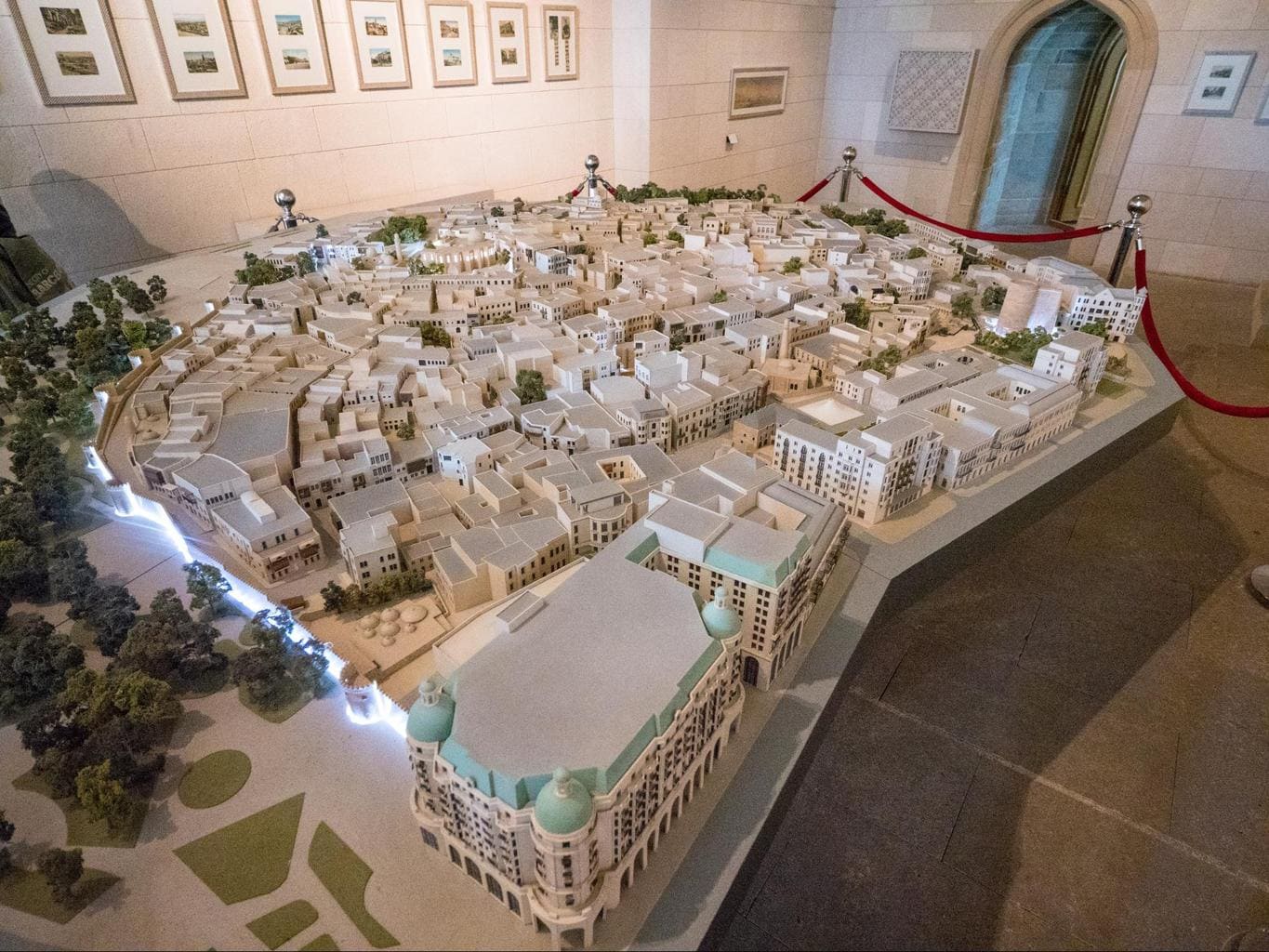
The Palace is the most beautiful building in the Old City of Baku and definitively worth a visit. Inside, there are lots of relics and artefacts exhibited, including jewelry and clothing from the Shahs. It is a living museum of Azerbaijani history.
11. Agha Miyakil bath house
I marked this on the map but it is not on Google or Google maps. Although hammams used to be very popular in the past, there are not a lot of them left in their old stage. This one is open and operational just as it used to be. Hammams in Azerbaijan are open on alternate days for men or women so be sure to check the days it is open for you.
12. Heydar Aliyev Center

Not to confuse the name with several other buildings and constructions which also carry the name of the first President after the fall of the Soviet Union.
Heydar Aliyev Center is an award-winning Zaha Hadid design chosen as the best building in 2014. The building was awarded after a contest launched in 2007 and opened in 2012.
It is a construction reminiscent of the Guggenheim or the Sydney Opera House but has difficult to photograph aesthetics with large proportions, flowing lines that undulate and seem to merge inside and out. On the exterior, the building feels like it’s hugging and embracing the large plaza it’s found in.
There are snails and other colorful sculptures that add a dash of color to the otherwise white and green grass space. It is this fluidity in the construction that creates a truly unique emotion in the visitor and was chosen to reflect Baku’s Islamic past where calligraphy and elements tend to flow into infinity.
Click on the arrows below to scroll through all my photos of Heydar Aliyev Center.
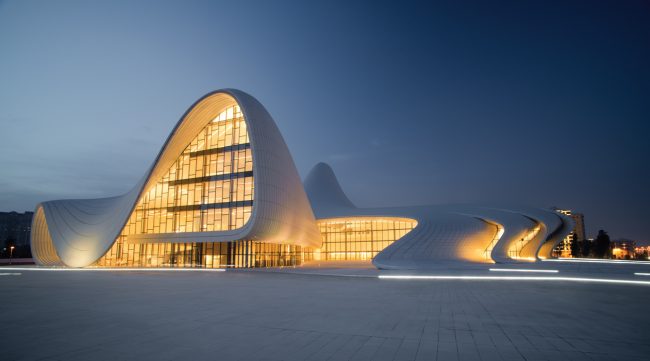
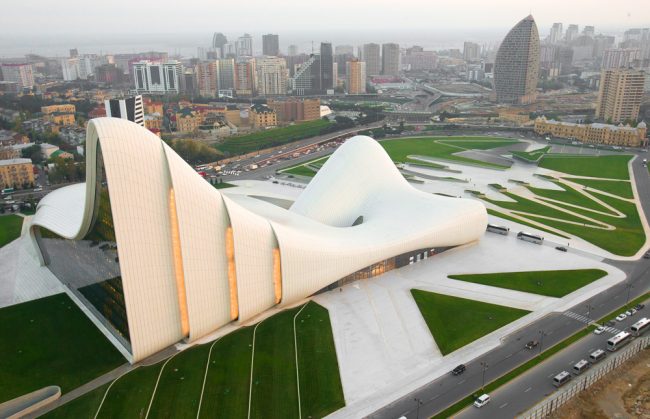
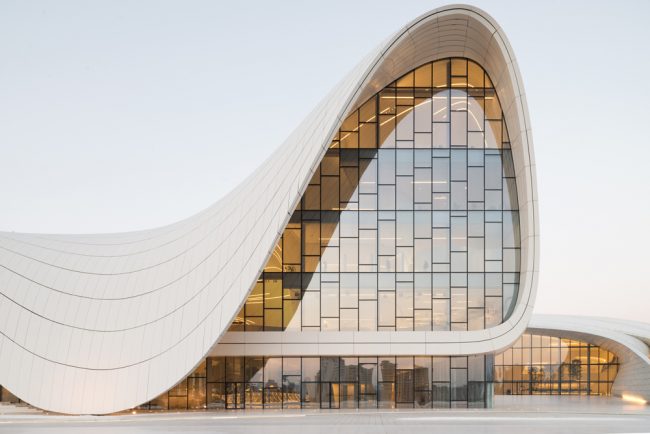
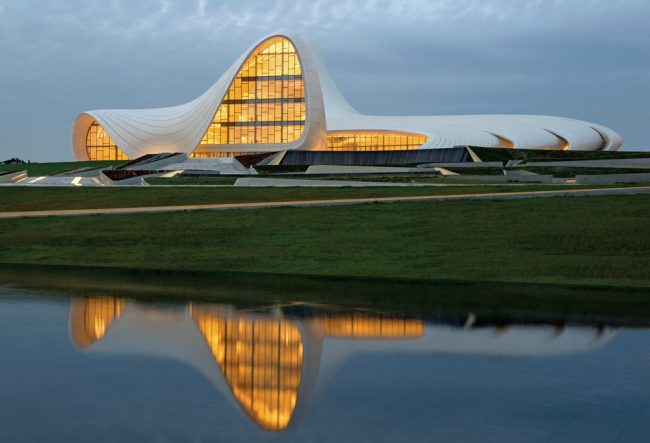
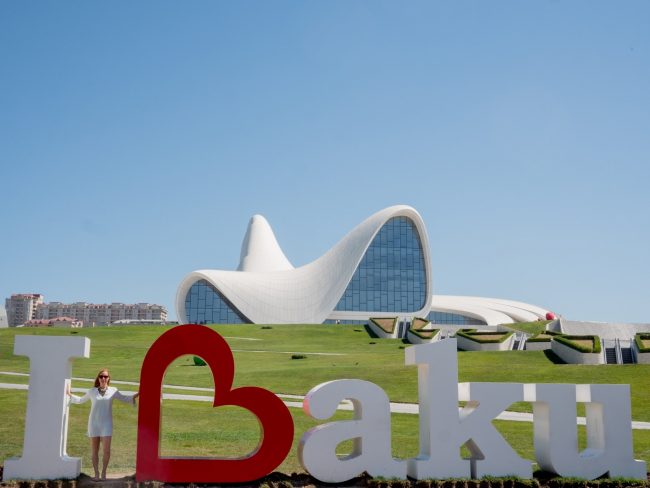
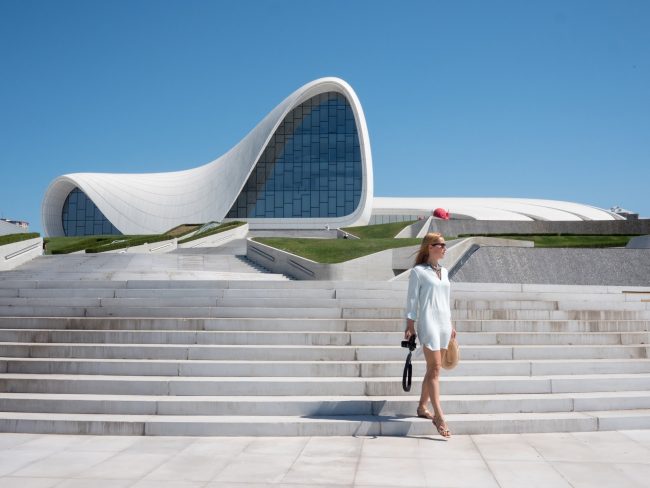
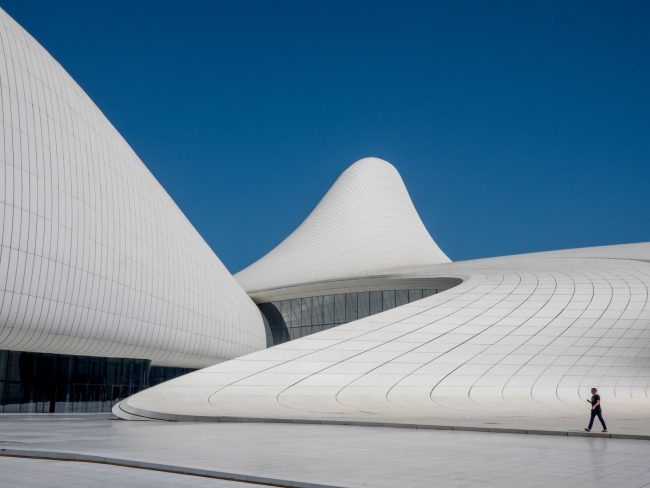
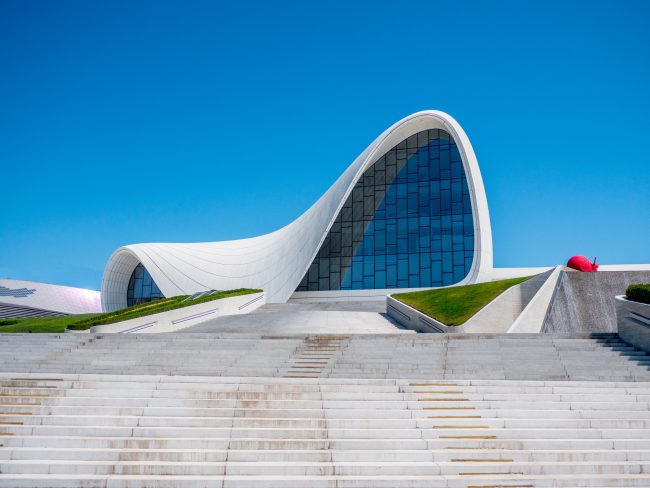
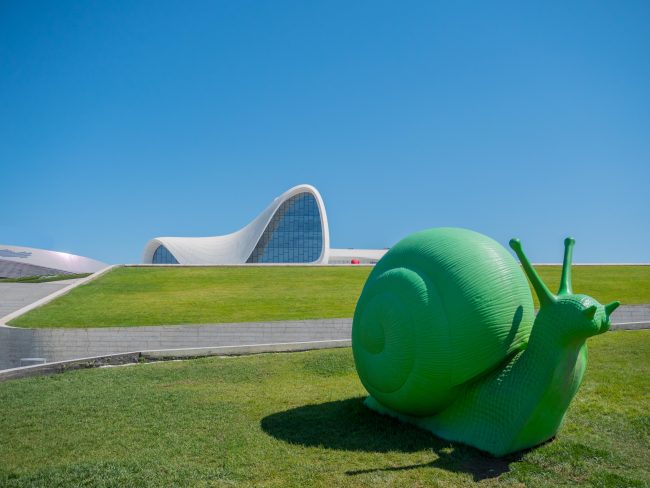
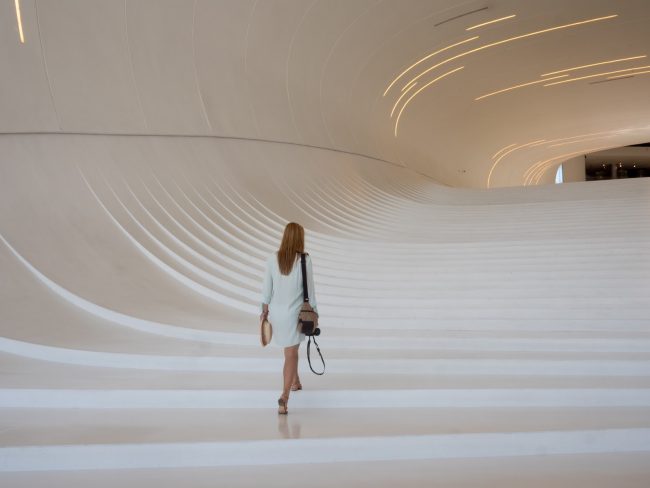
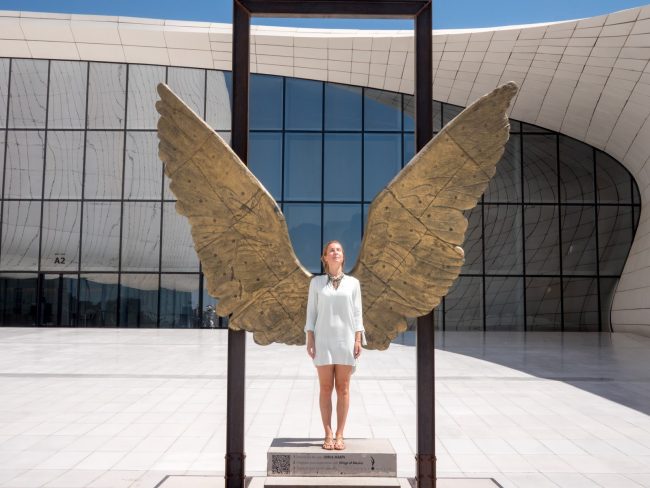
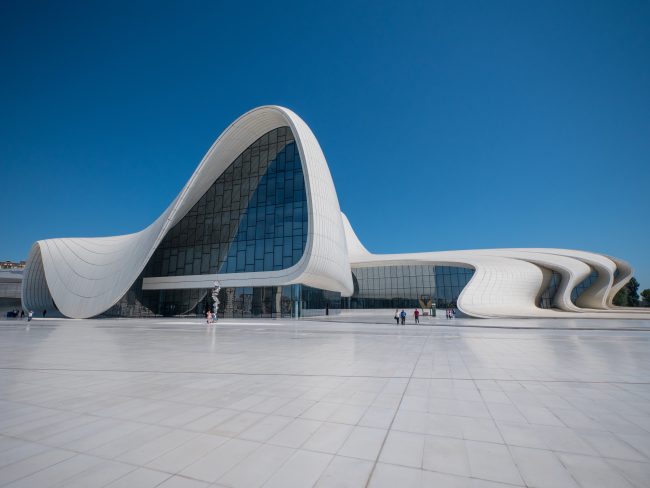
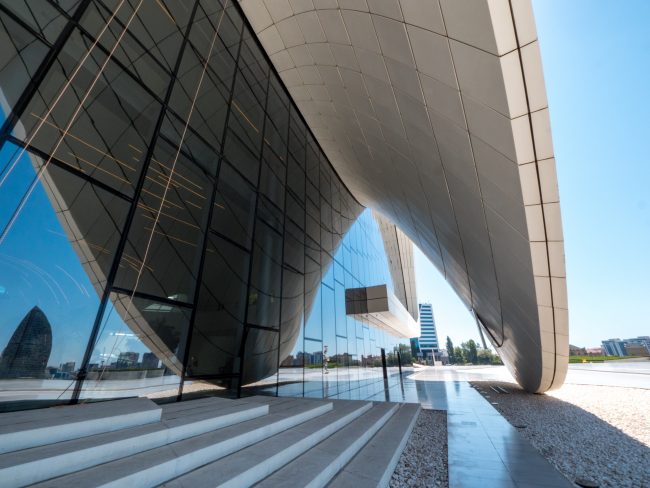
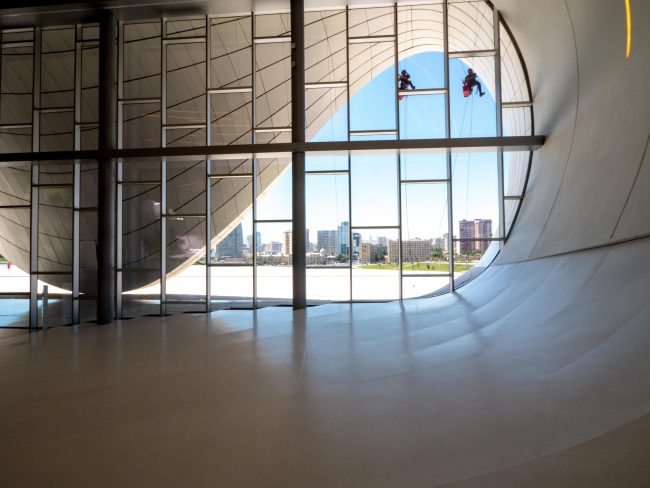
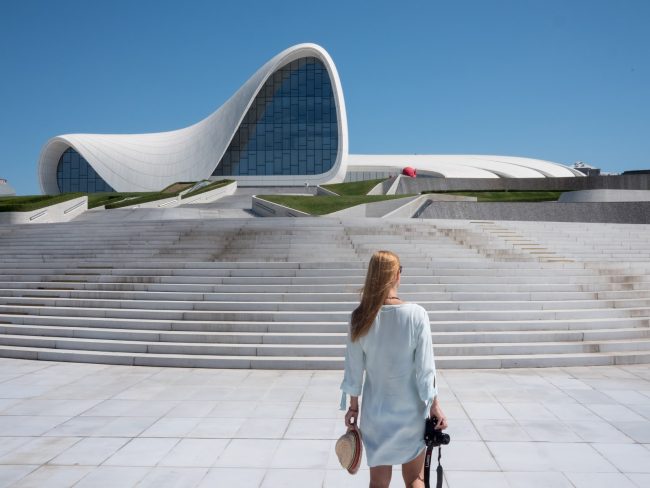
Inside, the center was built to showcase Azeri culture and exhibitions hosted tend to talk to local culture. A series of international exhibitions are also regularly shown. Although you might be tempted to visit it only from the outside, I would suggest going in. The main stairs going to the upper floors will make you feel like you are inside the belly of a large white whale.
There is a hip cafe following the same architecture as the building and free water is available at the ticket counter office from a water tank. Expect to spend a couple of hours at least visiting the center.
13. Mini Venice

As the name indicates, this is a Venice replica with canals and small boats manned by the staff for a leisurely evening. As the area is mostly under the sun, avoid the hot hours of the day in the summer months.

14. The Carpet Museum
The Carpet Museum houses thousands of carpets accumulated over 50 years since its inception during Soviet times and is housed in a purpose-built building shaped in the form of a rolled up carpet. Carpet weaving is one of the country’s oldest and most priced skills and traditions. The museum is very active and regularly hosts talks, lectures and workshops.
15. Bulvar
The most pleasant way to spend an evening in Baku is having a stroll along the Bulvar, the sea boulevard that stretches over a couple of kilometers along the Caspian Sea. The area is permanently packed with people, especially in the balmy evening in the summer months. There are families strolling, friends having a chat, teenagers playing, people eating, relaxing on the benches…it is a very nice way to enjoy Azeri life.
Baku and Azerbaijan Travel Guide – Best things to do in Azerbaijan
Although there is enough to see in Baku to keep you entertained for at least two or three packed days, there is a lot to see and do in Azerbaijan so it pays to take a few days trips to see some of the most interesting sights.
1. Mud volcanos
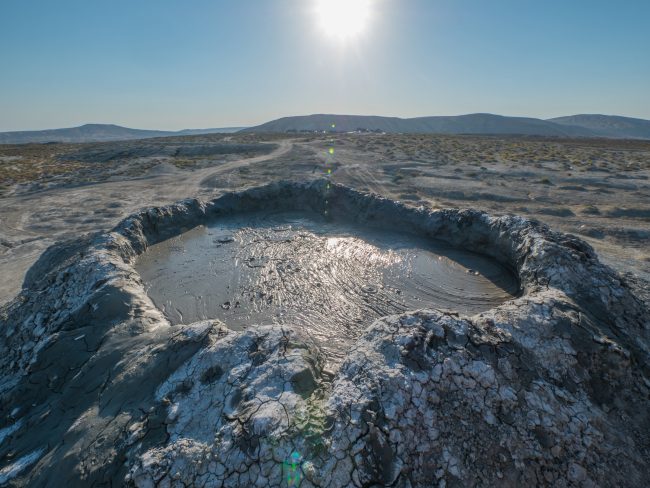
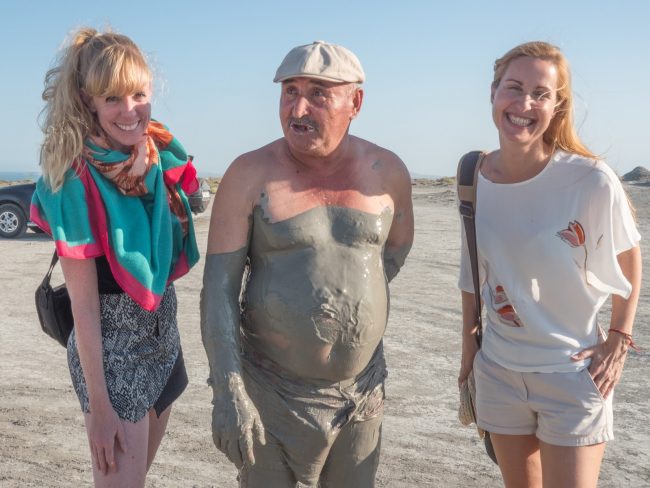
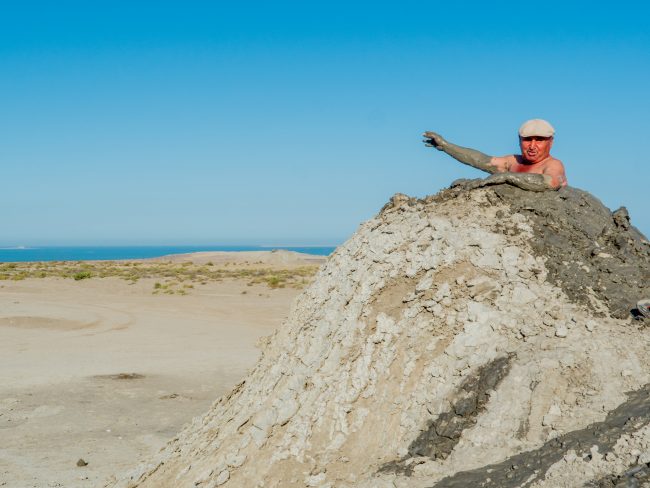
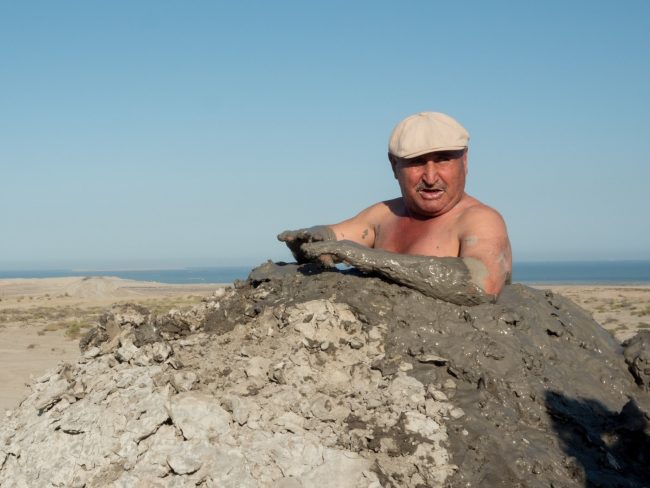
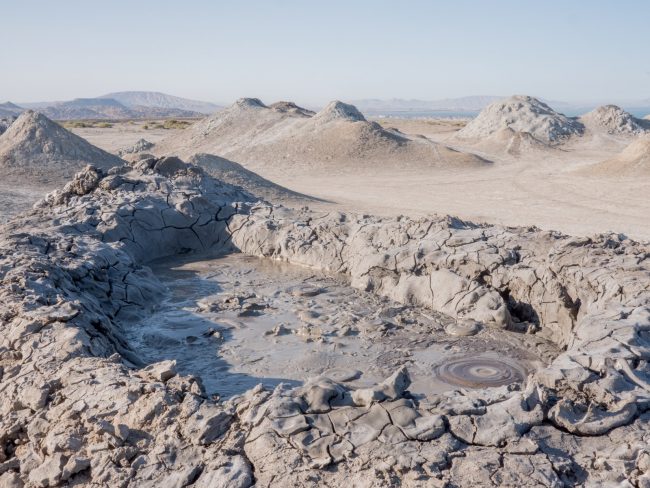
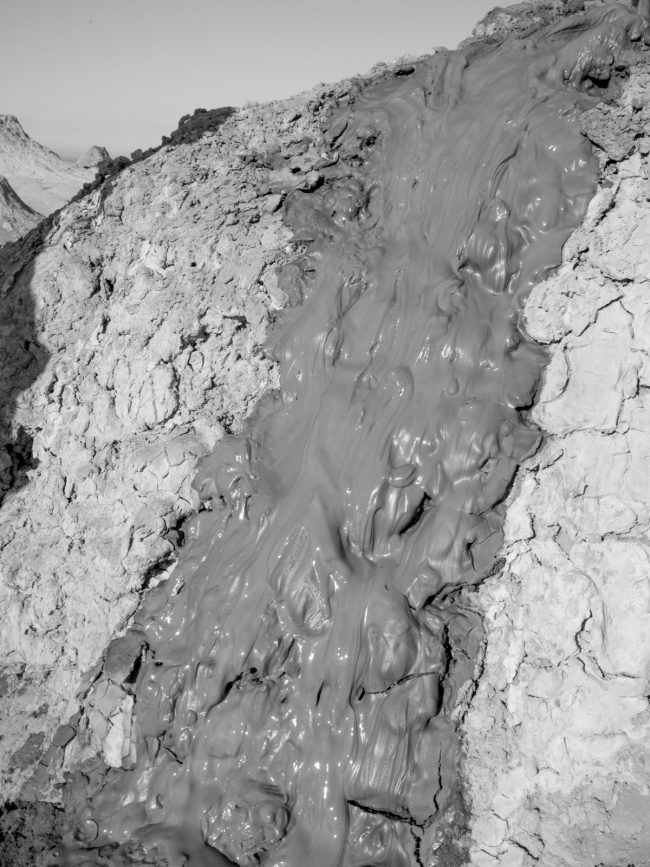
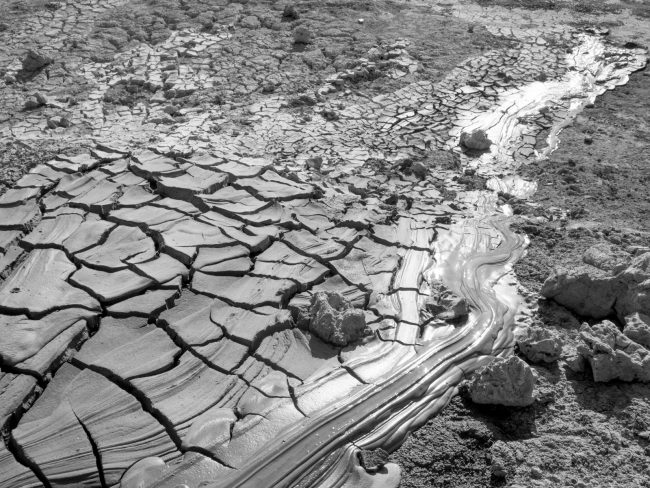
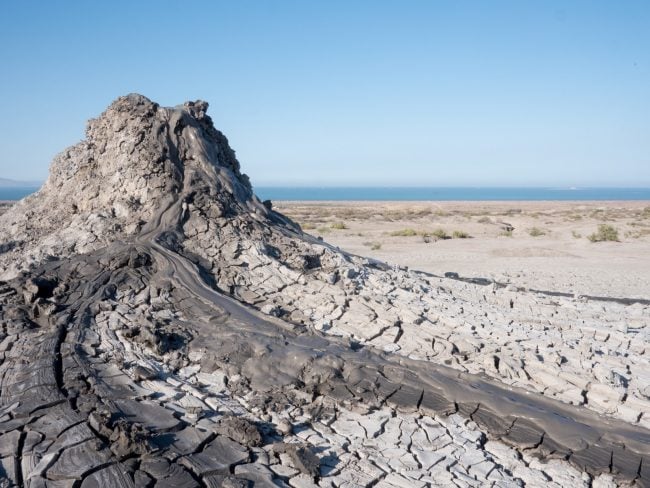
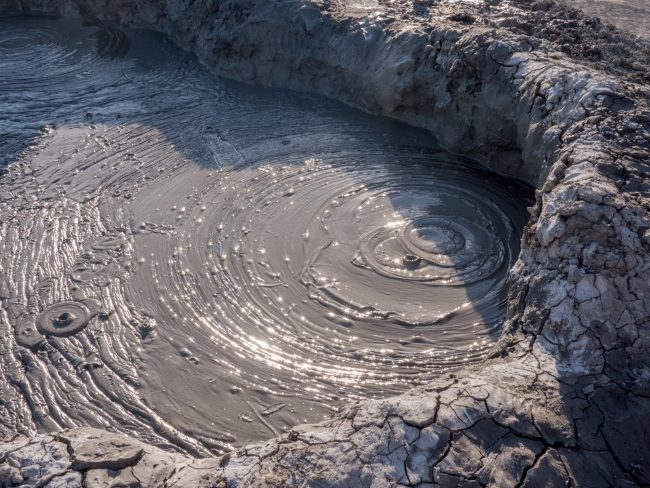
These are some of the oddest and weirdest things you will ever see. Azerbaijan is home to about a third to half of the world’s mud volcanos and they can be found less than an hour away from Baku. Mud volcanoes are a strange phenomenon caused when the gas found underground finds a weak escape in the ground in the form of mud and escapes through the openings. As these volcanoes are not made of magma, they are not hot, in fact they can be quite cold.
Locals in Azerbaijan consider the mud from these volcanoes to have wellness characteristics and you may be lucky to spot a local or two having a mud bath inside the volcano, quite an interesting sighting. But be careful if you want to do the same as some of the volcanoes are bottomless and you would drown straightaway.
There are a few locations near Baku to see the volcanos but the best ones are in Qobustan as they can easily be combined with a visit to the rock art.
2. Gobustan rock art

This is another of Azerbaijan’s UNESCO sites located about an hour’s drive from Baku and added in 2007. The Gobustan rock art dates back to 40,000 years ago and is remarkably well preserved. UNESCO lists 6,000 rock engravings from various periods and visitors can go to only one of the mountains as the other two are not open to the public. The museum adjacent to the rock art has interactive and detailed panels and exhibitions that help understand life in the area.

The petroglyphs engraved on the rocks gives evidence of animals that are today extinct in the world, like the wild ox, or in the area, like dolphins which no longer exist in the Caspian Sea but are represented in Gobustan. The area is also a great place to understand more about the lives of peoples inhabiting it in the Paleolithic age.
One of the interesting drawings that have made it to become the icon of the Gobustan art rock museum is the symbol of a schematic boat. There are a few theories to explain why boats were depicted. One refers to the importance of the boat in those times where locals lived mostly from fishing. They could also be the vehicle to transport the dead to the afterlife.
3. Yanar Dag
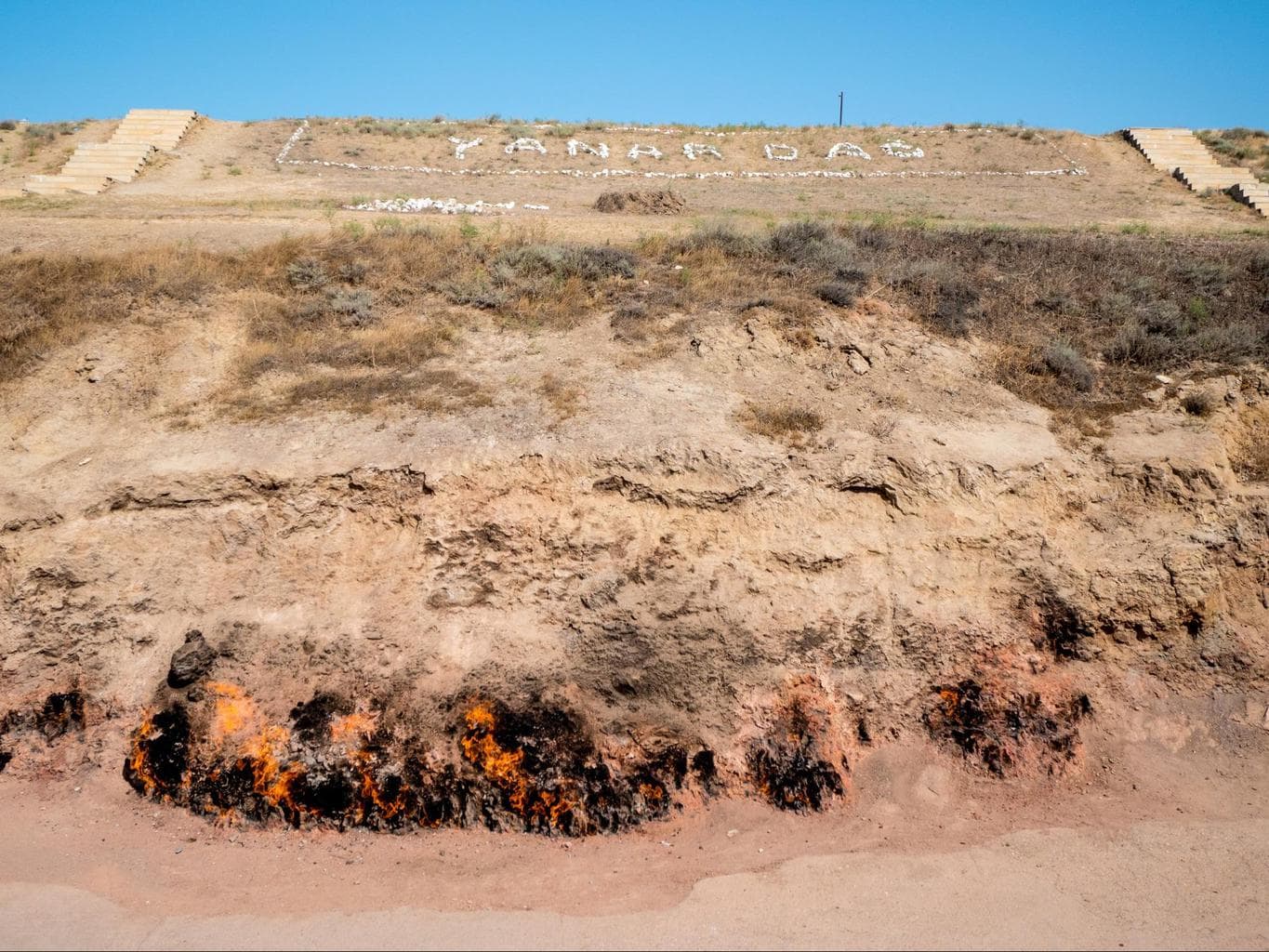
This is one of the sites in the country which contributes to its pseudonym as The Land of Fire. Yanar Dag has been burning for the last 4,000 years. The mountain burns in itself, and not because someone set the escaping gas on fire. The mix of gases escaping through the mountain burn when in contact with oxygen. And so this has been happening for the last four millennia.
The site is located about an hour from Baku and expands about 10-15 meters long and about a meter high. The flames don’t go very high, at least not when I was there, but the intense heat make this is a massive fireplace. The area is filled with the smell of gas and the flames look like they will be soft and tame in temperature, like the electric fireplaces you sometimes find in upscale bars, but they are in fact very hot so you cannot get too close.
4. The Diri Baba Tomb

This mosque and cave carved on the mountain side is practically hidden until you get very close. You can climb the stairs, enter and even go up the roof, on top of a mountain. There is a mausoleum and tomb of a saint called Diri Baba. There are public toilets at the base.
5. Ateshgah
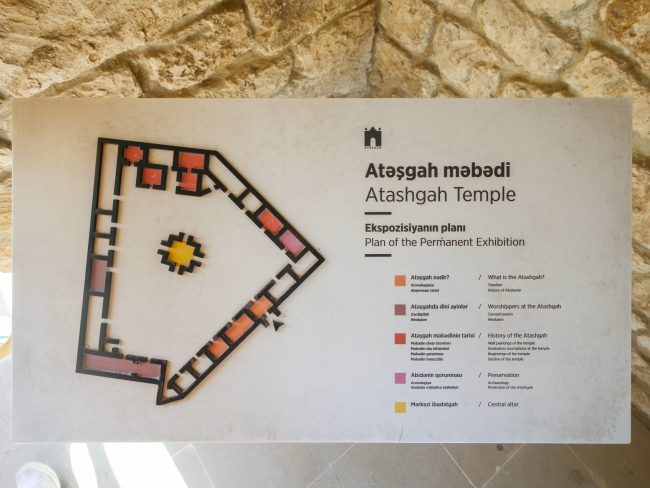
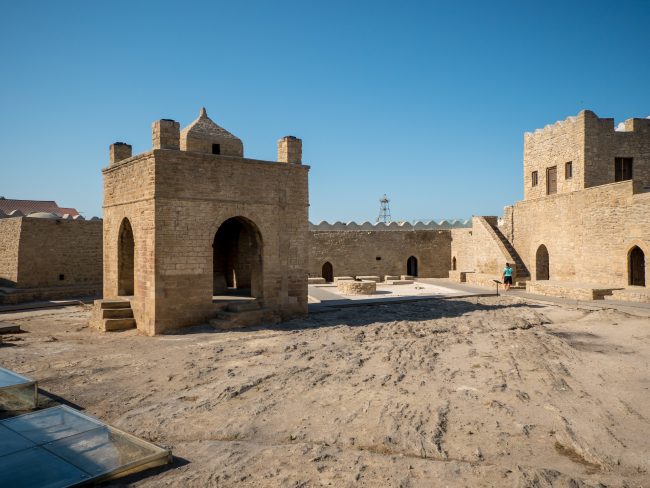
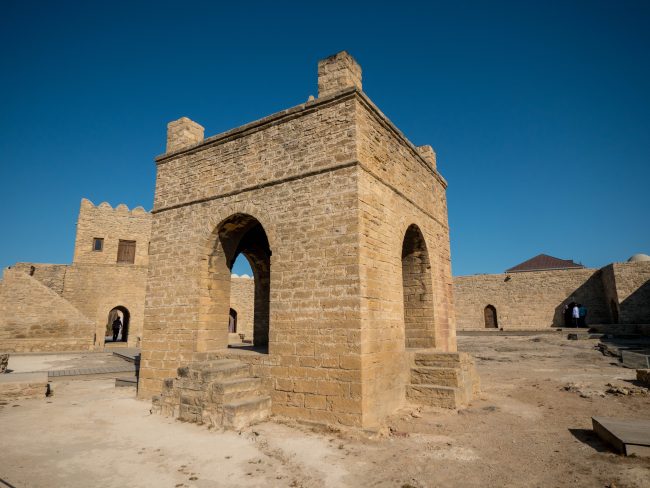
Ateshgah is a UNESCO listed fire temple located near Baku that has been the center of Zoroastrianism, Hinduism and Sikh pilgrimage for many centuries. The fire used to burn naturally, through gas escaping the earth from the underground gas fields, but that stopped in 1969 when the gas and oil exploitation in the area exhausted its reserves. The Azerbaijani government rechanneled gas from Baku towards the original flame in the 1980s in an effort to preserve the area. Its name comes from the Persian for “House of Fire”.
The temple is octagonal and the flame rests at its center, in a four-pillar altar. Surrounding it are several chambers or rooms that were used for different purposes when they were created and today house a permanent exhibition explaining the origins of the temple and the fire worshipping. They resemble a caravanserai in structure, with the dwellings for the worshippers and pilgrims located around the flame in a dark cave-like shape.
The exact year of construction of the temple is unknown, as with many other constructions in Azerbaijan. Historians and evidence points at the 18th century given that there is reference to a fire temple located in the area in Sanskrit and Punjabi documents. It is likely that people used to come here in their Silk Route trading to worship fire well before the temple was built.
There is also no clarity as to whether it was originally a Zoroastrian or a Hindu temple whose followers venerated fire. The construction, the elements, the architecture and the design point at either of the two religions without concluding elements. Several priests and experts on both religions have visited through the years to testify to either of its pedigree, but have failed to find conclusive evidence. A visit to the temple points to both religions and worship practices equally.
6. Jummah mosque Shamakhi

This Friday mosque is one of the most impressive and colorful you will find in Azerbaijan. There is a courtyard with arches in blue and a colorfully painted and decorated interior. Women must cover their heads but they have scarves at the entrance. You will not be allowed into the praying hall but you can observe it from the entrance and see the beautiful ceiling.

7. Nohur Lake
A man-made reservoir very popular with the locals for an afternoon in the open under shaded trees. You can go on a horse carriage ride, a boat on the lake or simply enjoy some tea. Honey and nuts, typical of this part of Azerbaijan, are on offer at the few stalls and you can also buy the typical sweet and sour pickled fruit pancakes.
8. Tufandag Mountain
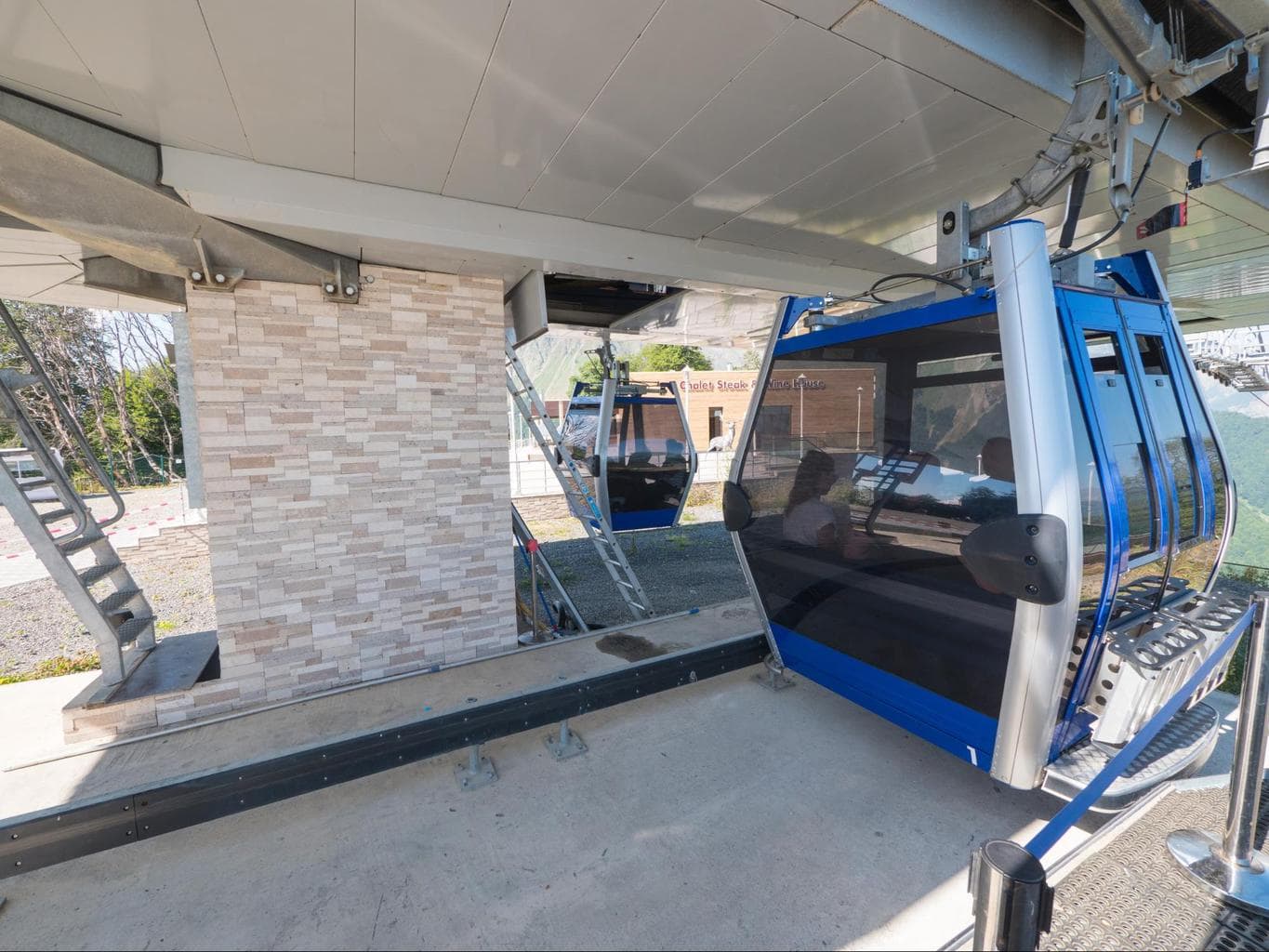
On your way to Qabala you may want to stop for a cable car ride up the mountain at Tufandang resort. Here, in the winter months you can see snow and go skiing in Azerbaijan’s latest ski resort. In the summer you can enjoy fresh air. The cable car has two stops and at the top you have nice views of the valley. The mountain here is over 4,000m high so even in the summer the temperature is pleasant. There is a resort at the base of the mountain which provides a good overnight option in the area with a side of mountain air.
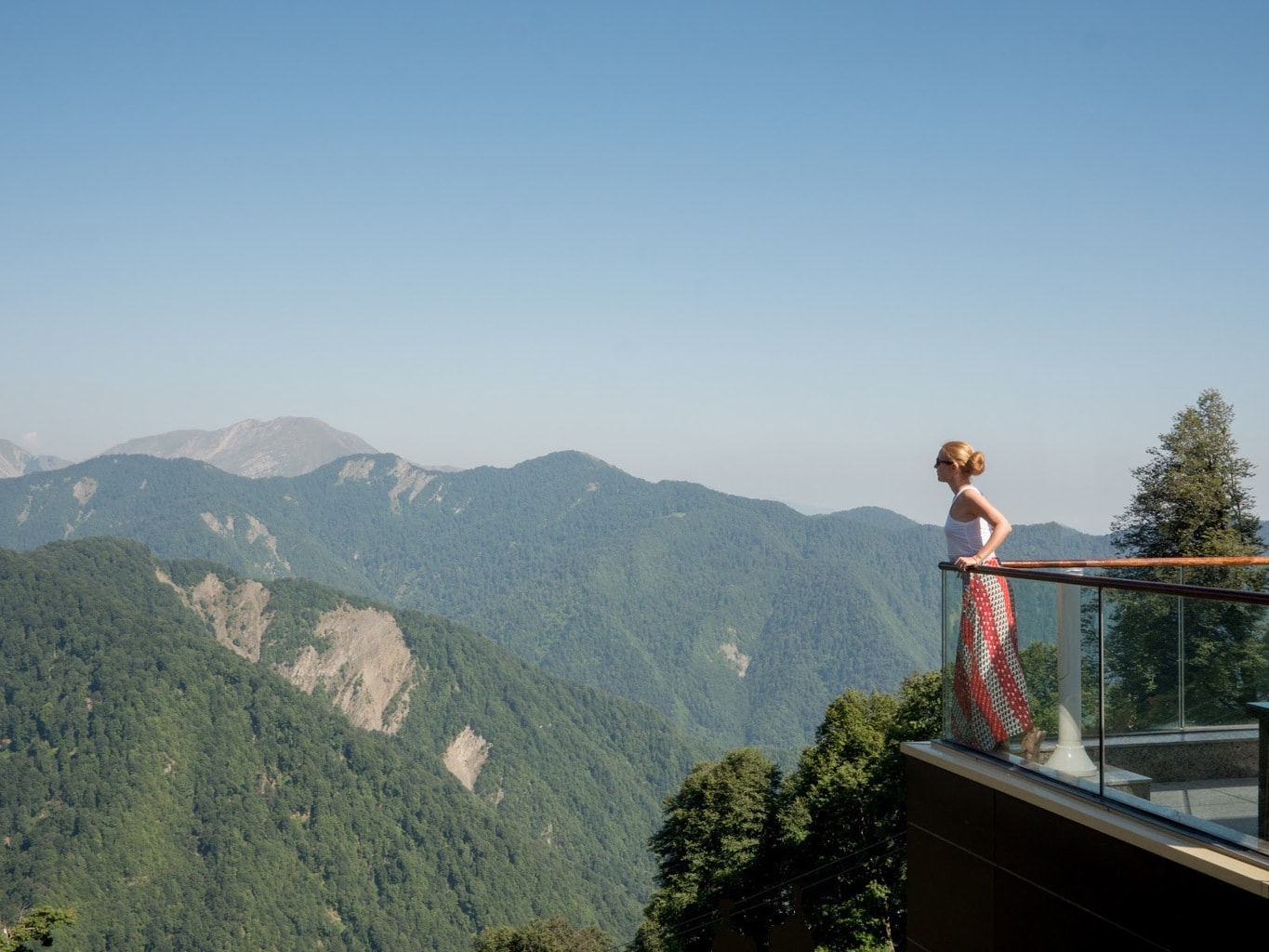
9. Qabala
If you go to Qabala to spend a night then you should have enough time to also visit some of the local production factories and outlets selling all the agricultural goodness the area has to offer from fruit to nuts and honey. Check out the nut factory behind the Gillian Hotel or stop at the stalls selling them on the side of the road.
10. Ruins of the city of Old Qabala

An ancient city was found buried underground a few years ago and has started to be restored, although slowly. If you want to feel a bit like Indiana Jones this is the place. You will most likely have the entire area to yourself as few people make the 3-4h journey from Baku but it is well worth it for the opportunity to daydream about an entire city underground. It is believed that Old Qabala was the capital of Caucasian Albania 2,500 years ago and with time, it got covered in soil and was abandoned.
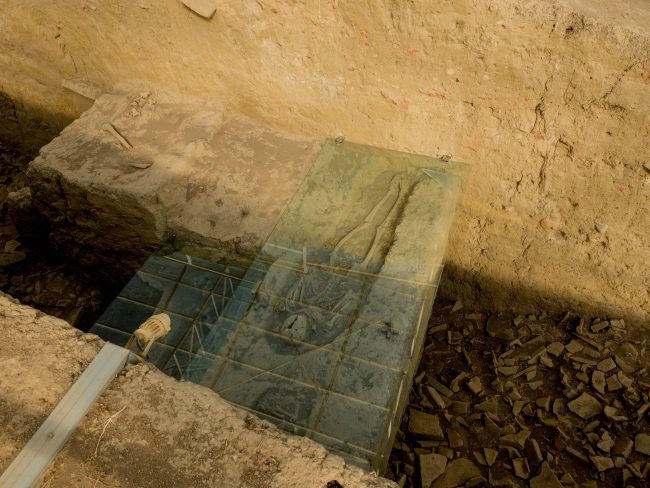
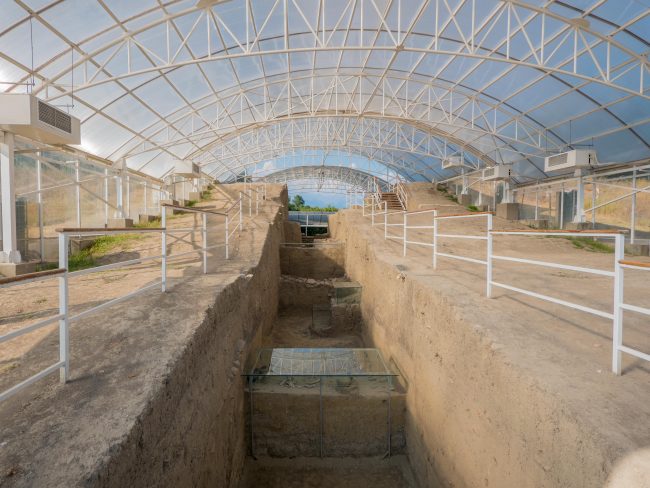
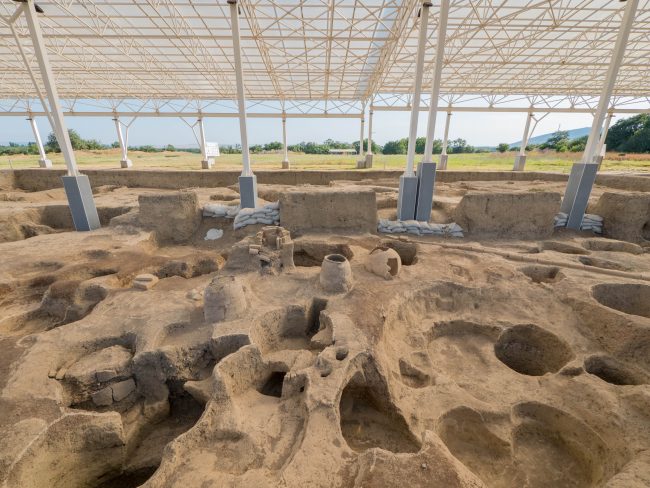
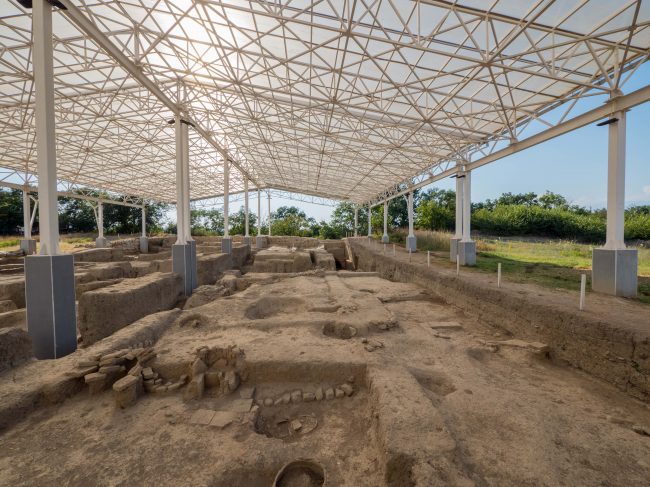
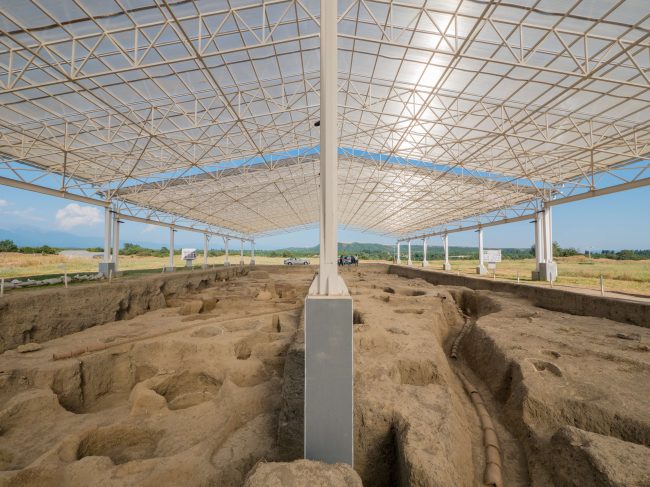
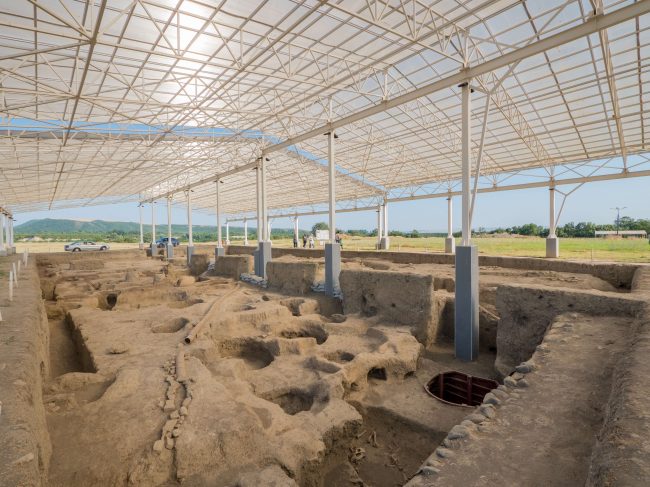
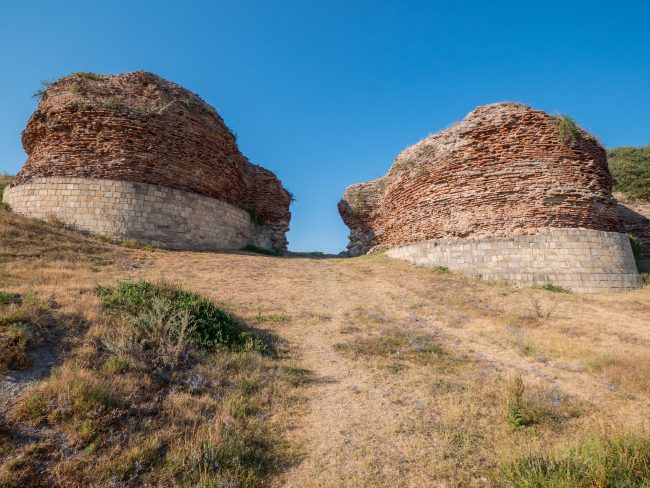
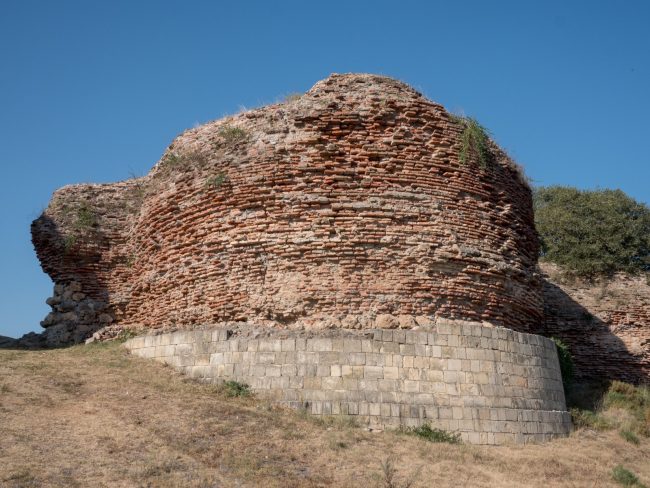
What you can see today are the remains of the city gates and some parts of the fortress walls. The parts that have been excavated show an entire city with houses, wells, market streets, etc. All the relics found including bones, pottery, artefacts and jewelry can be seen at the Museum that is at the entrance.
11. Sheki
This mountainous city in the north of Azerbaijan is a popular skiing destination. As it is far from Baku, you will want to make an overnight trip out of it perhaps visiting Qabala on the way.
In town, apart from the mountains and landscapes you would also want to make sure to visit Sheki Khan’s Palace which is renowned for its colorful Venetian stained glass and the fact that the entire building was built without using any type of glue or adhesive.
While you are there, drive a bit further to Kish to visit their church, a good example of 12th Caucasian Albanian architecture. You can read all about the city in this guide to Sheki.
Baku and Azerbaijan Travel Guide – What to eat in Azerbaijan
Food in Azerbaijan is a wonderful mix of East and West, of Turkish, Mediterranean, Persian and even Indian elements all blended into a fantastic array of recipes. Some of the most typical Azeri dishes like kebab or tea can also be found elsewhere but here they seemed to taste better. Do not leave the country without trying some of the following dishes.
1. Plov or pilaf
These are typical rice dishes similar to the Indian Biryani or the Moroccan ones. What I loved about Azeri pilaf is the touches of spices and dried fruits. Mutton or lamb are the most common meat but chicken is also readily available. Rice in Azerbaijan is usually flavored with saffron and cinnamon plus lots of dried fruits like apricot or even dates and chestnuts.
2. Kebab
The omnipresent typically Turkish and Middle Eastern dish is perhaps the most common item in Azeri menus. Expect to find all types of meats and preparations skewered and barbecued. Vegetables may also be added and the meat could be minced and made into balls.
3. Qutab
A delicious sort of savory pancake filled with meats and vegetables like spinach for the vegetarian version. There are also cheese qutab and often times you can order a sample of a few flavors. Qutab is served with yogurt and sometimes sumac (a spice/herb mix).
4. Dolma

Definitively the staple in Azerbaijan are dolmas. You may have tasted them in the Middle East as they are typical Lebanese dishes but in Azerbaijan they can be stuffed vegetables or the stuffing can be wrapped around vine or cabbage leaves.

The three options are great and the filling tends to be similar, made of meat and vegetables, but the choice of wrapping gives it a different touch. The cabbage or vine leaf dolmas can also be served in a gravy sauce.
5. Dushbara

The equivalent of the Nepalese/Bhutanese/Mongolian momo or the Japanese gyoza these are meat dumplings that in Azerbaijan can also come in smaller size and in a broth.
6. Pakhlava and badambura

Pakhlava is the most renowned Turkish sweet that is also eaten in Azerbaijan. Incredibly sweet and filling I can usually only stomach half of it but it is a great companion to strong black tea. Made of layers of thin pastry and nuts with honey definitively only for the sweetest of tooths. Badambura is slightly less sweet and has no honey so it is less sticky as well. It is filled with plain sugar and almonds so it is definitively filling too.
7. Ghuru Kingal
This dish is best described as a deconstructed meat dumpling. Imagine a plate filled with a base of dumpling steamed pasta then the filling of a usual dumpling would be placed loose on top.
8. Saj
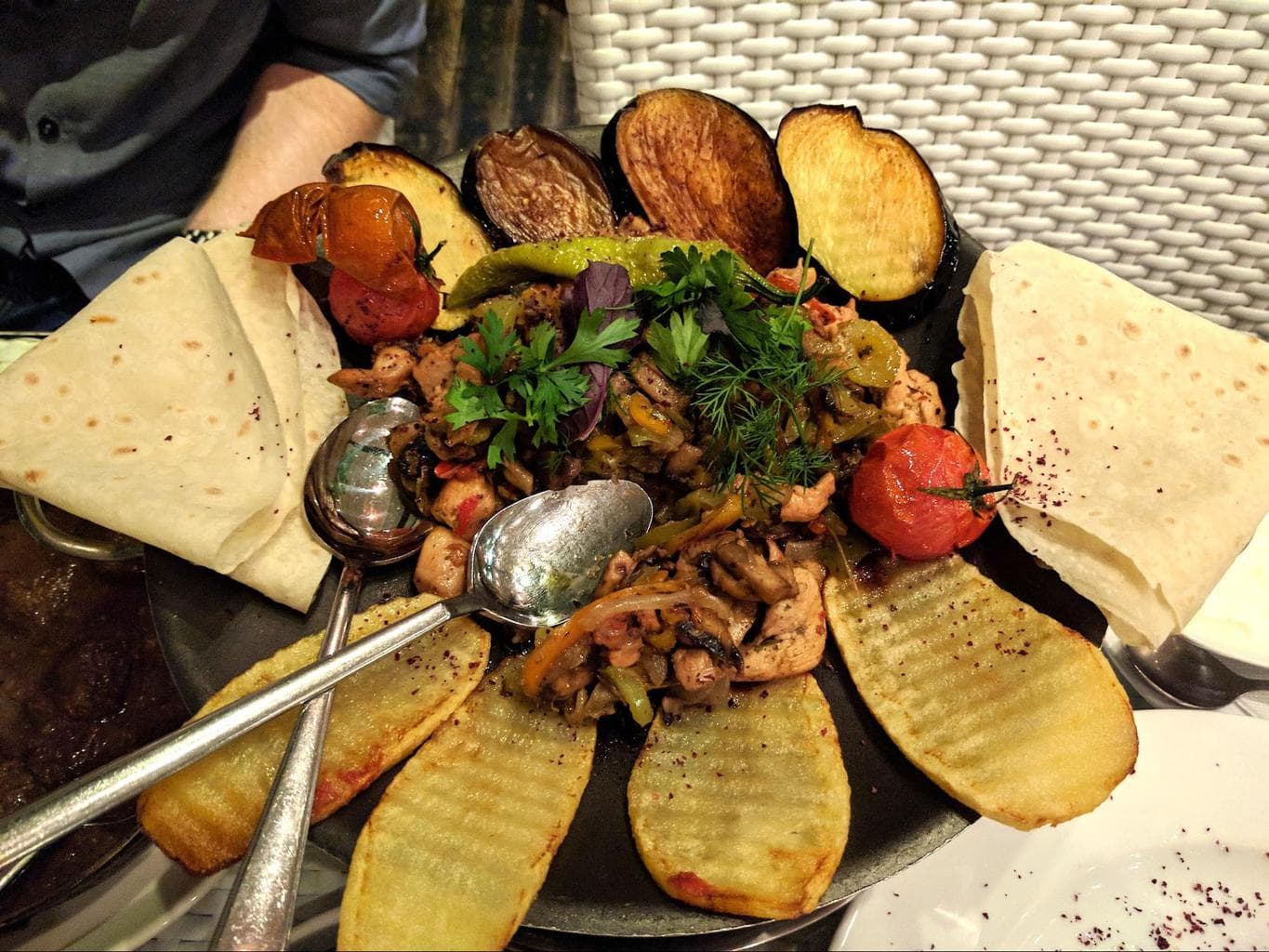
This is a meat and vegetable dish usually served in the traditional saj copper dish which comes to the table over a coal brazier or flame. This was the traditional cooking method for it and some restaurants (like Zeytun), still serve it like this. It comes with the stir fried meat in the middle with some of the fried vegetable slices placed around it and maybe some pieces of flatbread (like the one used to serve a kebab).
9. Typical Azeri breakfast

We were in search of a breakfast option because I booked a hotel without it in order to enjoy the local specialties and were positively surprised by the great Azeri traditional breakfast served in the typical cafes. Azerbaijanis eat tandoor baked bread with honey, butter, cream and fresh cheese and copious amounts of tea with jam. Although these are not exceptional ingredients or components at a breakfast table, they are unique.

10. Tea with jam

Perhaps the most uniquely Azeri dish to try is the tea with jam. Locals drink their tea with a side of jammed fruit. That is, fruit that has been slowly baked with sugar as if to make jam, but has been left in intact pieces. When we were there it was the season for figs so our tea was served with entire figs that had been cooked in sugar as if to make jam.
You are not meant to eat the jam but to place the piece in your mouth and drink the tea through it. This was actually one of the best ways to drink tea as I am not a big fan and do not necessarily enjoy its bitterness. Result! The jam completely masked it. A slice of lemon may also be added.
11. Piti
This is another unique dish that I have not seen anywhere else. Piti is a lamb stew served with potatoes and chickpeas with an intense flavour. The ingredients, especially the added lamb fat, are probably enough to clog all your veins, but is it tasty! What makes it extra special is the way it is served with the broth in which it was cooked poured into a bowl and the stew enjoyed from the earth pot. Our server even mashed the stew before serving it to us so it was deliciously blended with the potatoes, lamb and vegetables all mixed in.
12. Nuts

Azerbaijan produces a lot of nuts, particularly walnuts and hazelnuts so in the summer, when they are in season, you will see them being sold everywhere, roadside, in street stalls, in shops… be sure to try them out and, if you’ve never seen them before, buy them raw, inside their shells.
13. Lavash Turshu

This has to be the weirdest and strangest item I have ever eaten. It is difficult to explain but try to imagine a sweet, salty and sour pickled fruit pancake. That was a mouthful. They basically take fruit, cook it slowly with vinegar and sugar to make a sort of jam, then spread the jam into pancake shapes and leave it to dry in the sun.
It is sold roadside everywhere outside of Baku and also at market stalls and their colorful appearance is hard to miss. It is not so common to find it in shops but certainly unique. Turshu is actually a vegetable pickle that is very common in the Caucasus region. Turshu lavash can also be made with vegetables like cucumber.
Baku and Azerbaijan Travel Guide – Where to eat in Baku
Baku has a host of restaurants and cafes and the locals like to socialise and eat so the popular traditional style ones in the Old City and surroundings are always full. Fancy and modern places also exist but are fewer and although enjoyable, I found the local places were the best way to enjoy Azerbaijani food. These are the best places to eat in Baku, most of which I tested or were a direct recommendation from friends.
1. Evde Bar and grill
A well known and established restaurant that was under renovation when we visited but came recommended in every guide and by every friend. It is a modern take on local Armenian and Azeri cuisine in hip environments. Owned by the Beat Group, the brand behind the poshest places in Baku and the beach clubs on the coast.
2. Shirvanshah Muzey Restoran
Located in an old building and made of a few rooms each decorated with local artefacts and items. Shirvanshahs Musey is a true museum restaurant and the food is local and reliable. More an experience than other places, the food is served in beautiful plates and the ambience is regal.
3. Firuze
Perhaps my favorite place. A very traditional basement restaurant serving local food in a cozy setting. Expect carpets hanging from the wall and all of Azerbaijan’s typical dishes on offer including Piti and Shah pulau, the very interesting rice dish cooked inside a crunchy cake.
4. OroNero
OroNero is the poshest restaurant in town and possibly the only fine dining option. It is located at the JW Marriott Hotel and serves Italian food so a good option if you want a change from the local Caucasian food.
5. Zeytun
One of the few restaurants which comes with a view. It is located at the top floor of a shopping mall by the sea boulevard and has views over the shoreline. However, in the summer months beware that the glass walls come up so it is not technically outdoors. The food is traditionally Azeri and delicious with one of the most extensive menus I have seen including lots of international dishes and a long list of soups and grilled meats (kebabs).
6. Sahil bar and grill
Another great option, I preferred it to Zeytun, by the sea boulevard and with views. This time, with outdoor seating, truly under the stars and next to a merry go round. Food here is also traditionally Azeri and the staff was very friendly and useful. All the dishes were tasty and the setting perhaps a bit more refined and pleasant as we could enjoy the balmy evening outside. Inside, Sahil is a swanky bar with a New York feel to it.
7. Mugham Club
Mugham Club is a caravanserai with very beautiful interiors and decor also located in the Old City. Inside, the rugs and carpets as well as the glass roof provide a cozy yet familiar feeling and you can enjoy Azeri dishes just like the traders used to do centuries ago.
8. Art Garden

Located in the Old City, Art Garden is one of the three main caravanserais that are close to the Maiden Tower and belong to historical buildings. Sit in the now tented courtyard of this caravanserai and enjoy local food. You can also come here for a tea in the afternoon, if you need a break from the Old City tour. This is one of the few places in the Old Town you can actually drive all the way to.
9. Çay Bağı 145

With possibly the best location in town, Çay Bağı 145 is a tea house and cafe located right above the old market ruins with perfect views of the Maiden Tower, the hammam and the old market. At night, this is one of the most pleasant places to enjoy a tea and shisha. Alcohol is not served here but they have a huge selection of teas. Do as the locals do and come people watch.
10. Sehrli Tandir or Qazmaq

Two of the few great breakfast options along the fortress wall of the Old City. Here, the staff cook the bread fresh in the tandoor just before serving it to you piping hot. Sitting down in these unassuming local and casual places is a great way to watch the day go by with a glass of strong tea and a large piece of local Azeri bread right from the grill. Enjoy breakfast like the locals, with bread, butter, cream, sheep cheese and honey. Tea must be sipped with pieces of sweet jammed fruit. Visit their Facebook pages here and here.
11. Royal Garden
This large restaurant is a lovely gem in the fortress walls of the city. Shaded under vine leaves and opening onto the street the verandah is a great place for lunch. Inside, the restaurant is huge with several levels and a maze-like structure typical of buildings in the Old City. The food is local and delicious and the staff are friendly. A great choice for a casual lunch in the old town but very accessible through the wall’s side door which is right in front of the restaurant.
12. Chinar
The only hip and fashionable lounge bar in town where you have a bit of a modern city feel. Chinar is located in what once was a traditional cafe. Here people are dressed up and come to see and be seen. Cocktails are good so it is a good pre or post dinner stop and the food is creative and unusual in their fusion approach. The outdoor terrace area with cabana style seats and the Xian terracotta warriors greeting you are something different in Baku.
13. Entree bakeries

This is a chain so there are a few in town but if you are looking for a breakfast spot it is a great choice for a western inspired bakery with large croissants and freshly cooked eggs. There are a few branches but the one marked on the map is their flagship store. Baku is not a morning city so this is likely one of the few places open in the morning (before 9am) on the weekends.
14. M’eat Steakhouse
If you are looking for a good cut of meat in a loft-inspired leather sofa, brick walled environment, M’eat is the place for you. Owned by the Beat Group, M’eat is masculine, refined and seems to appeal to real men. Their wine list is quite decent, especially since wine is hard to come by in Baku, and the food selection is more Argentina than Baku but if you fancy something beyond traditional Azeri dishes this is a more international choice.
Where to stay in Baku – Best luxury hotels
Baku is slowly becoming a modern city with lots of luxury hotels on offer. In the last five years a Fairmont, JW Marriott and a Four Seasons have opened their doors to guests in flashy buildings, especially the Fairmont’s location in the hilltop Flame Towers.
1. Fairmont Baku Flame Towers
As flashy hotels goes this is probably encapsulating the spirit of oil-rich Azerbaijan better than any other hotel. The Fairmont Baku is located in the Flame Towers that are, literally, lit with an interactive flame video every evening. The towers are a combination of hotel and office space and are shaped like flames, standing tall up on a hill at one end of the city. It is impossible to miss them as they are visible from any point in the city, in particular from the Old City center and the Maiden Tower as they align with the main market and old merchant street.
The hotel is large and has great views of the city with the entire crescent shaped sea boulevard visible from the sea-facing rooms. Beware that the location is tough if you like walking. Going up to the top of the hill requires a series of snaking roads and so it is not a straight walk up. At night, the area is not properly lit so taking taxis is the best way around.
Inside, expect the modern international look of a Fairmont anywhere else and lots of facilities including a spa, a few outdoor pools in various shapes and forms around the roof of the main area between the three flame-shaped buildings and even an indoor pool for the winter months.
The downsides? There were three things that were not up to par for a 5* star hotel. The service was disappointing, not so much in the staff but in the processes to deal with situations. The glass walls in the pool area looked like they had never been cleaned and were white from all the accumulated dust. The room servicing was erratic at best, forgetting to replenish towels or other items. The staff is incredibly friendly and nice, but their processes and instructions to deal with certain situations are just not up to the service level you would expect from such a hotel. Skip breakfast, it is not worth the price. Average spread and food, no fresh juices, egg station which quickly gets crowded, definitively nothing to look forward to for the price of a traditional luxury hotel breakfast. Try the local breakfast in town instead.
See my full review and in-depth review of the Fairmont Baku Flame Towers here.
2. JW Marriott Absheron
Expect the usual JW Marriott service level with a touch of classic and good old-fashioned approach. The JW Marriott Absheron Baku is located in the sea boulevard so a better location than the Fairmont and near the Hilton. There is a pool on the 21st floor which has great city views and everyone praises the hotel’s service, the key differentiating factor from a JW Marriott as I experienced in Singapore at their designer South Beach hotel.
Its location and the array of restaurants to eat at are both useful aspects if you are here on business. Their rooftop terrace is a good place to enjoy an afternoon drink and the JW Marriott is home to the best restaurant in the city, OroNero. The swimming pool is indoor and has nice views but there is no outdoor one. The rooms are spacious and modern with free-standing bathtubs and views of the entire boulevard or the city. Reviews talk about a good breakfast.
3. Four Seasons Baku
This is the city’s most prized landmark hotel and the standard for luxury accommodation in Baku. The Four Seasons is usually at least twice as expensive as all the other hotels in the city and with a higher standard also comes another level of service and accommodation. For starters, the hotel is on the wall of the Old City so if you are coming for sightseeing this is probably the best place to stay at. The building is reminiscent of European 19th century architecture in continental European cities like Paris or Milan and has a grand entrance with white-gloved staff and red carpets. Inside, Four Season’s timeless service and classic rooms dominate. Marbled floors, ample staircases that wrap around grand lobbies, you get it.
Rooms come with balconies out onto the Caspian Sea, a welcoming change from the office style closed windows of other luxury hotels in Baku. There are built-in TVs in the period mirrors, and the pale pink interiors and the carpeted floors give a sense of old-fashioned charm and elegance. Of course there is an indoor pool and also a hammam and jacuzzi. Evenings can be spent in the outdoor terrace with a shisha.
This is definitively the place to stay if you can afford it.
4. Hilton Baku
This is one of the best places to come enjoy a sunset drink in their rooftop terrace so even if you are not staying there, make sure to enjoy a drink or dinner with city and sea views.
The Hilton is located on the sea boulevard and has lovely views like the JW Marriott or the Fairmont. Expect the usual international standards of a modern city hotel geared towards business. Inside, large spaces, bright colors and good value. There is no outdoor pool here only an indoor one. The Hilton Baku is also home to the only revolving restaurant in the city.
For other hotel recommendations in Baku and Azerbaijan check out our detailed guide to the Best Luxury Hotels in Azerbaijan here.
Logistics and practicalities about traveling to Azerbaijan
1. Getting a visa for Azerbaijan
What once used to be a country requiring visitors to get a visa is now an e-visa destination with a quick and simple process done online in a couple of minutes with just your passport details and arrival date needed. Processing takes three days and even if you get the visa before, its starting date will be three days after application so plan for that. Apply for the visa directly here.
2. How to get to Azerbaijan
To get to Azerbaijan you can fly several airlines. I took FlyDubai which has twice daily flights from Dubai, a major hub which linked me well coming from Singapore. FlyDubai also has flights to Qabala in the north if you need an alternative landing option. Qabala is about 4-5h from Baku by car and a good place to start nonetheless but be sure to organise a driver if you want to go straight. Or spend a couple of days there first then head south to the capital and depart onwards from there.
Other major airlines flying into Baku include Turkish Airlines, Lufthansa, Aeroflot, Emirates, Qatar or Air France.
The airport in Baku is one of the nicest (if not the nicest) I have ever been to. It is new and beautiful with nice architecture and fantastic dining options. It is also empty so you will most likely go through pretty quickly.
3. How to dress in Azerbaijan
Azerbaijan is a country with nine out of the 11 climate types in the world. That means that you are likely going to need clothes for a varying degree of weathers, from the dry desert landscapes around Baku to the beach (if you plan to go) or the mountains.
While in the summer months it will be warm everywhere, in winter temperature in the northern parts, closest to the Caucasus, will be cold. When it is hottest, a hat and sunscreen are a must, especially if you will be visiting the Old City (as you should) and will be exposed to the sunrays.
I always like to use the Biore face sunscreen when I explore cities because it is not oily and you can put makeup on top of the cream. It also has a nice silky texture. Sunglasses are also necessary as the sun shines everyday. If you plan to visit some of the mosques mentioned here remember to dress with long trousers and long sleeves and to bring a scarf to cover your head.
Contrary to what I had read, I did not feel that the country is conservative in any way. I had read other female travelers mention that women should wear long sleeves and trousers / skirts but Baku did not feel conservative in any way, women were dressed as they would in most European cities.
They were maybe not as extreme as Spain can be in the summer where people seem to be at the beach rather than Barcelona’s city streets, but they were not covered up. Outside of Baku people tend to be more conservative but for most people that just means your regular dress code will be just fine. I wore shorts, t-shirts, dresses and sleeveless tops and I did not get any stares.
It is worth noting that most women do not smoke shisha and that some of the cafes are almost exclusively frequented by men. However, as a foreigner, I had no issues and we did order and enjoy shisha and the waiters did not even blink.
4. Getting around in Baku and Azerbaijan
The best way to explore Azerbaijan is basing yourself in Baku and taking day trips. If you plan to stay longer than just 4-5 days and want to venture beyond Qabala, you would be advised to spend a night or two in the area. Both Qabala and Sheki offer good accommodation options.
Baku is a walkable city that is very enjoyable to experience on foot. There are proper sidewalks and underpasses to cross the major roads (you need to use them no matter what). If you need to go further distances there is the metro or taxis which are incredibly cheap, especially if you use Uber. We were averaging $2-3 per ride and the drivers were pretty nice even if they spoke little to no English.
Make sure to write the right destination by checking it in Google maps and MyMaps first. Most places in Azerbaijan are spelled in different ways as there is no direct and commonly agreed way to transliterate the Azeri words so it is easy to get confused or not find a place on the map. Also bear in mind that a lot of landmarks are called after the President so if you are going to the Zaha Hadid building make sure to pick the right Heydar Aliyev landmark.
For travel inside the country you can rent a car from the major rental companies or ask your hotel to arrange a driver. We used the tour company which was stationed at the Fairmont who provided us with premium cars and a guide with driver for the tours that we did and were quite happy.
But it was expensive compared to other prices in the country. We spent around $60 per person for the half day tours and $100 per the whole day 10-hour trip with plenty of driving all the way to Qabala. We were 2-3 people per tour so it was private. You should be able to find cheaper in the usual platforms.
Driving yourself is easy and should not be an issue as I have marked all the places on my Google map but the signs are indeed in Azerbaijani language. Get a local SIM card to use Google maps or download their offline version. There are not a lot of signs for the majority of the sights so you should make use of my map.
5. Money matters in Azerbaijan

The manat, the local currency, resembles the euro in its appearance so it is easy to get confused.
Bear in mind that Amex is not accepted in most places except for hotels. Other credit cards are generally accepted, even to buy tickets for the main sights. Cash is always king everywhere but I did not see any issue with using cards.
Ready for Azerbaijan? Better Pin this guide to your travel Pinterest board just in case.
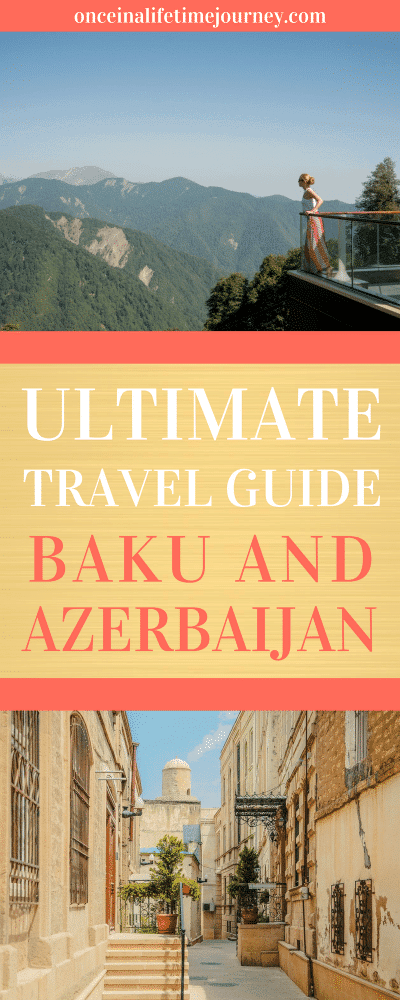
- Check if you need a visa, get help processing it at iVisa.
- Never ever leave without travel insurance. Get affordable coverage from World Nomads or long term insurance from Safety Wing.
- I find all of my flights on KAYAK. Check their Deals section too.
- Search for all your transportation between destinations on the trusted travel booking platform Bookaway.
- I book all my day trips and tours via GetYourGuide, they are the best and their tours are refundable up to 24h in advance.
- Get USD35 off your first booking with Airbnb.
- Compare hotels EVERYWHERE at HotelsCombined and book with Booking.com.
- Compare car rental prices at Rentalcars.com
